-
Posts
2,126 -
Joined
-
Last visited
-
Days Won
2
Content Type
Profiles
Forums
Blogs
Gallery
Events
Store
Posts posted by Rusty Greaves
-
-
I have found another cabinet portrait card from the Weinblatt photographic studio in Cairo that identifies it's location in relation to an early address of Maison J. Lattes. I previously illustrated an example in the first 2 photos of my post of 27 October, 2022 on this thread. The reverse of that undated portrait of a man wearing a 4th Class Order of Medjidie and a Khedival Star identifies the location of "Photographie Weinblatt" as "au dessus (above) J. Lattes, Mousky Caire". The 3rd photo in that post identifies the address of "Artistic Studio J. Weinblatt" as 4 Moosky Street, Cairo" on what appears to be a later (but undated) cabinet portrait with no mention of J. Lattes. That card identifies Weinblatt's studio as located "ABOVE TOBIA FOA SHOP'S [sic]". This indicates that Lattes had moved his shop to the El Manak Street location by the time those more elaborate portrait cards were printed for Weinblatt. The El Manak Street location is identified on 4th photo in that Oct 27, 2022 post showing the first page of the J. Lattes advertising flyer. A 6 April, 1916 receipt from Maison Lattes with his address as "Cairo Rue El Manakh" is illustrated on page 343 of the 2023 publication by Magdya Hanafy's Encyclopedia of Egyptian Protocol: Collars, Orders and Medals 1914-1953. Friends Group for Philately and Numismatics, Cairo, shown in the 2nd image of my post here of 7 January, 2024.
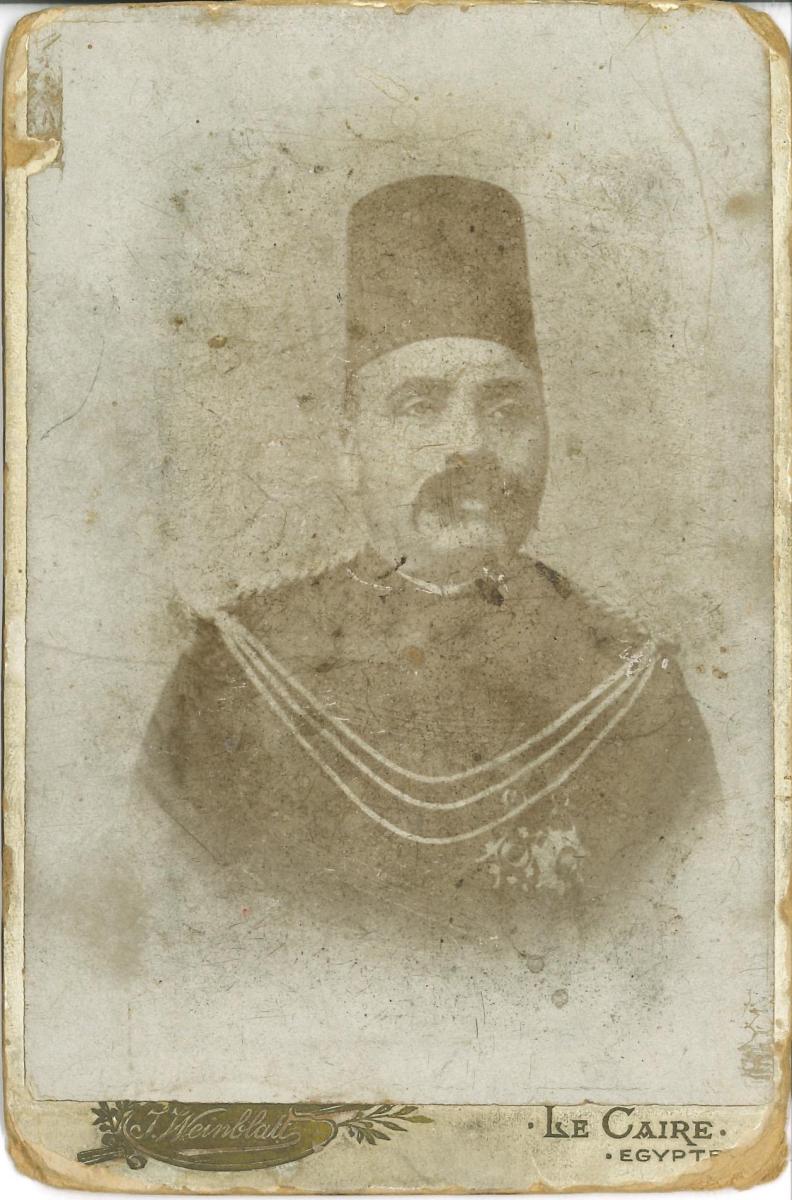
The above undated cabinet portrait by Weinblatt is from a recent eBay offering showing a military officer wearing medals of an Order of Osmanieh and an Order of Medjidie on the obverse side. This portrait measures 162 mm high x 106 mm wide.
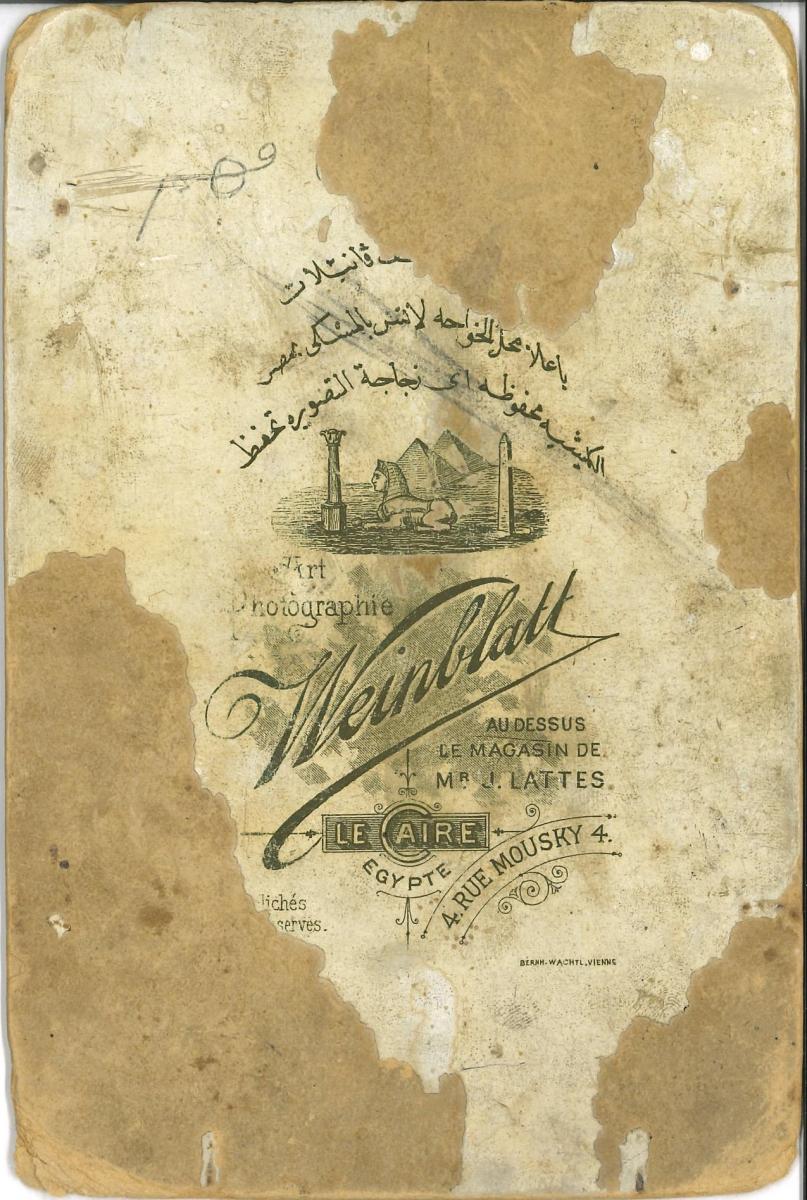
The reverse of this portrait is quite worn, but identifies the location of "Art Photographie Weinblatt" as "AU DESSUS LE MAGASIN DE MR. J. LATTES" (above the store of Mr. J. Lattes)" at 4 rue Moosky, Le Caire. This is only the second confirmation of this earlier address for Maison J. Lattes that I have found.
0 -
Below is a miniature Order of Ismail offered in a Feb 25, 2024 auction by La Galerie Numismatique (Lot 0110), listed on the liveauctioneers website (https://www.liveauctioneers.com/item/170362583_order-of-ismail). This mini is identified as measuring 35 x 21 mm, and the suspension ring and ribbon are stated to be original. The description does claim this is in “mint” condition. However, it is clear from the photo that there is damage to the enamel of the central boss with the inscription “Ismail”. It is unclear whether the lighter blue on parts of the enamel on this boss is an effect of the original enamel or some form of repair. The description also calls this “a spectacular very large size badge”. The width is similar to that of the other Order of Ismail minis of comparable design. However, the height (presumably to the most superior portion of the star within the crescent) is about 4mm taller than the only 2 examples I have been able to accurately measure and the few height measurement provided for other Ismail minis.
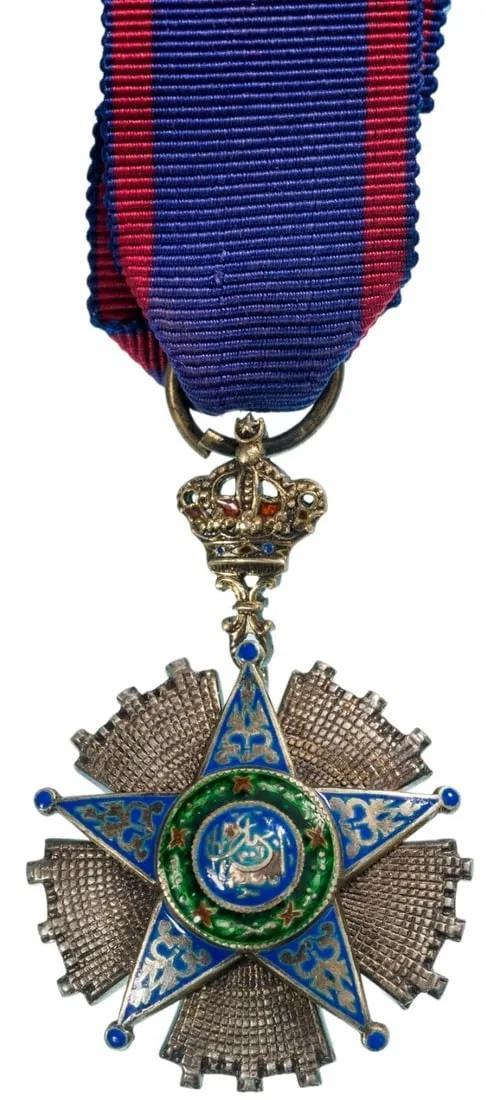
Moderate-resolution image of the obverse of the La Galerie Numismatique miniature Orde of Ismail from the liveauctioneers website. This shows well the blue and red enamel on the crown suspension element. Both this image and that below of the reverse can be zoomed for additional detail.
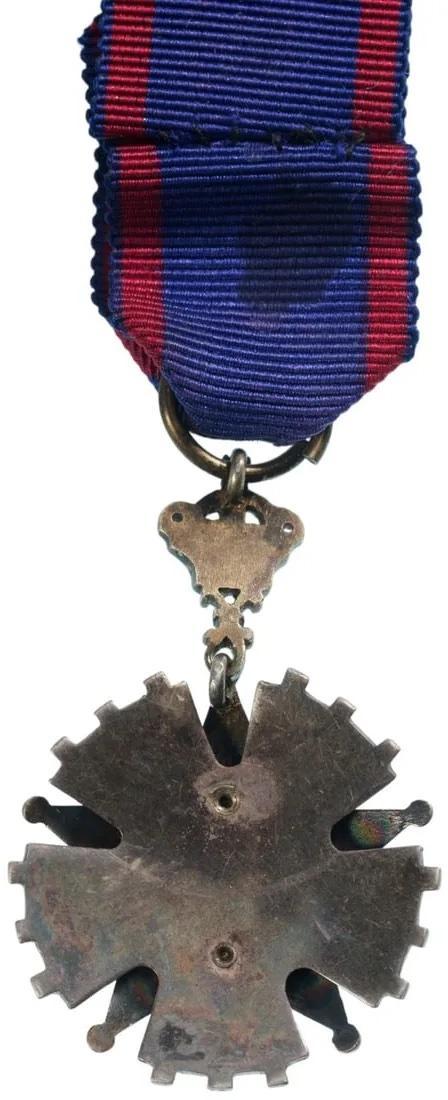
Moderate-resolution photo of the reverse of the same miniature order of Ismail from the liveauctioneers website.
I cannot tell from the above photos whether all of this miniature is silver or if there are some gold/plated elements. However, it appears this example is all silver (the description does not mention any gold or gilt). On most examples, the crown suspension device is gold or plated, but that does not appear to be the case with the above badge. The “Ismail” inscription looks to be silver on this piece as well rather than gold. Additionally, the borders and floral elements on this mini look to be silver and not gold as on most other examples I have seen. A low-resolution image of the Dr. James Ferguson Lees’ mini (from a 22 June, 2021 auction by Woolley and Wallace, archived on the Drouot Digital website, shown in the 4th photo pf my post on this thread of 23 September, 2021) also appears to show an all silver miniature. Other similarities between the La Galerie Numismatique mini and the Dr. Ferguson Lees badge are described below).
Another significant difference from most other miniature badges is the very abbreviated form of the red bands on the wreath. On the above example, these bands are simple Xs that do not wrap completely around the wreath or have well-defined boundaries (gold on other minis but apparently silver on this badge). The Dr. Ferguson Lees example may have this same form, but the photo of that mini is not high-enough resolution to confirm that suspicion. The margins of the rayed embellishment on this La Galerie Numismatique mini exhibits “extra” silver outlining the rays (especially noticeable at the distal ends of the shortest rays and margins of the cutouts in the embellishment.
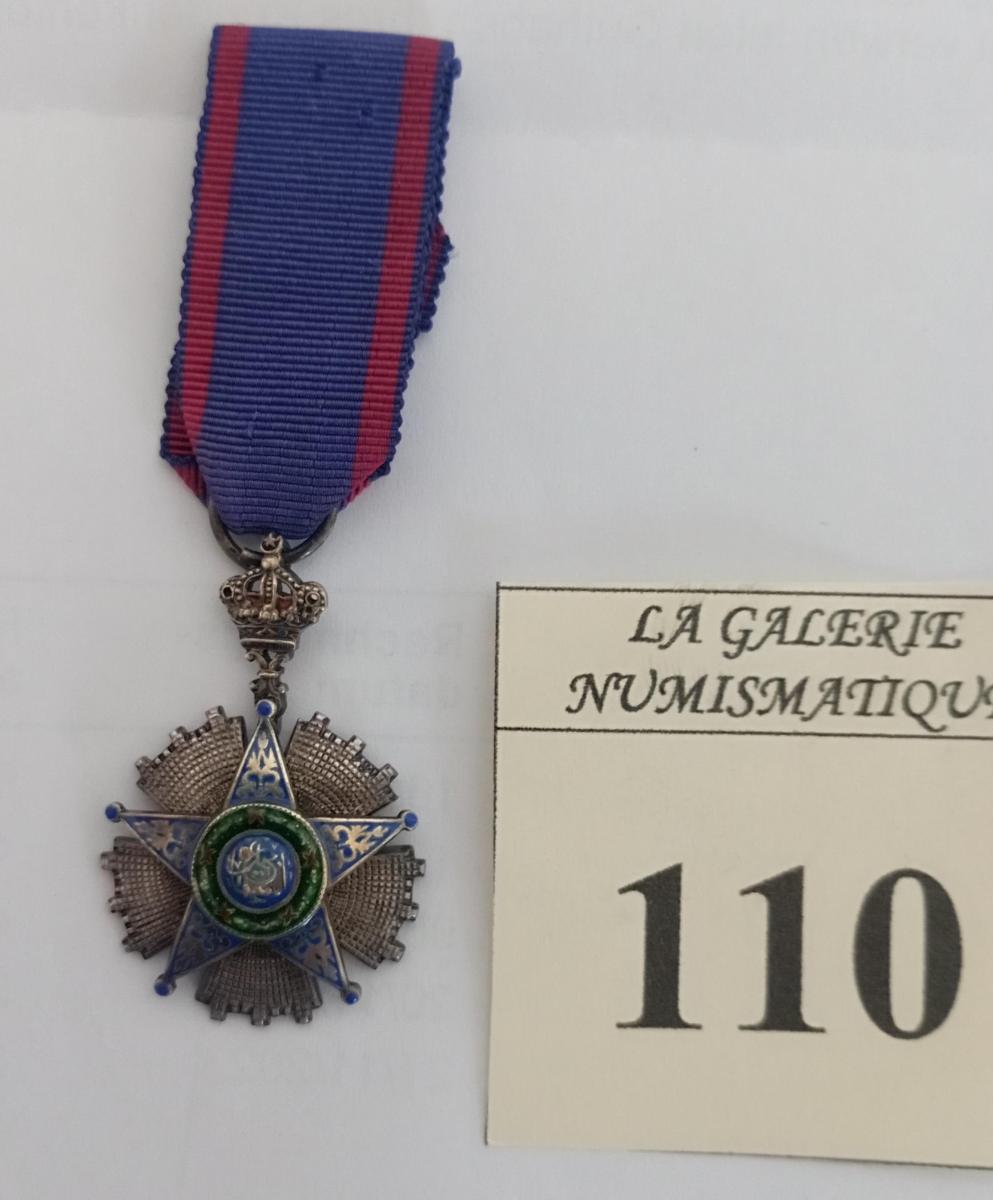
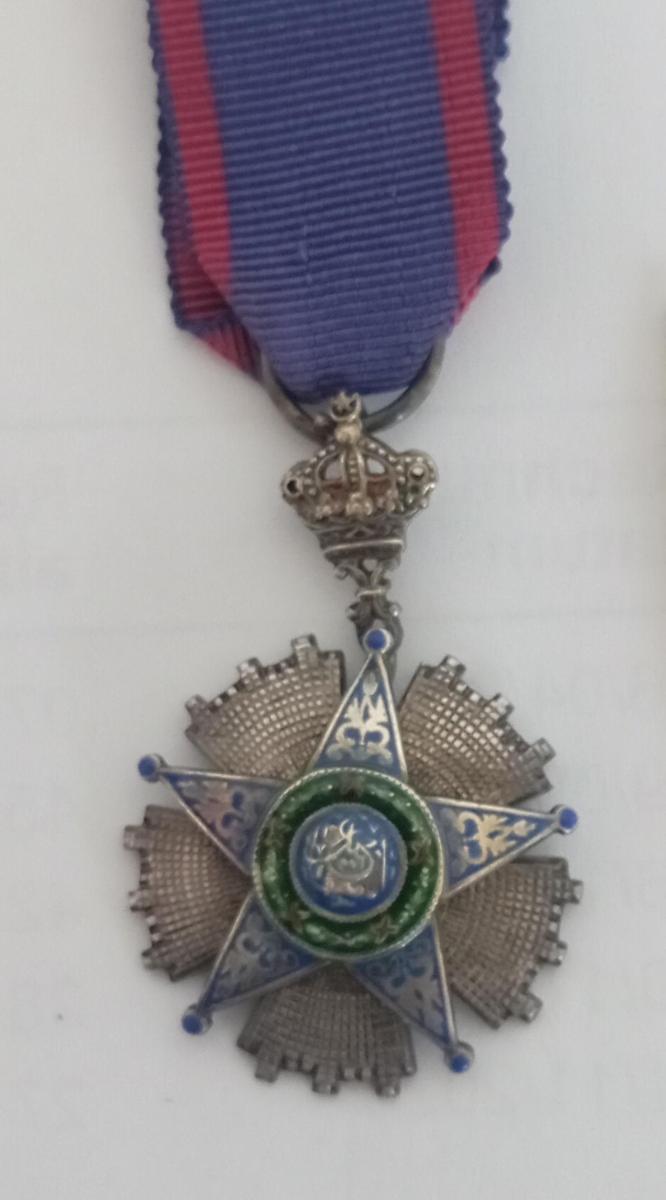
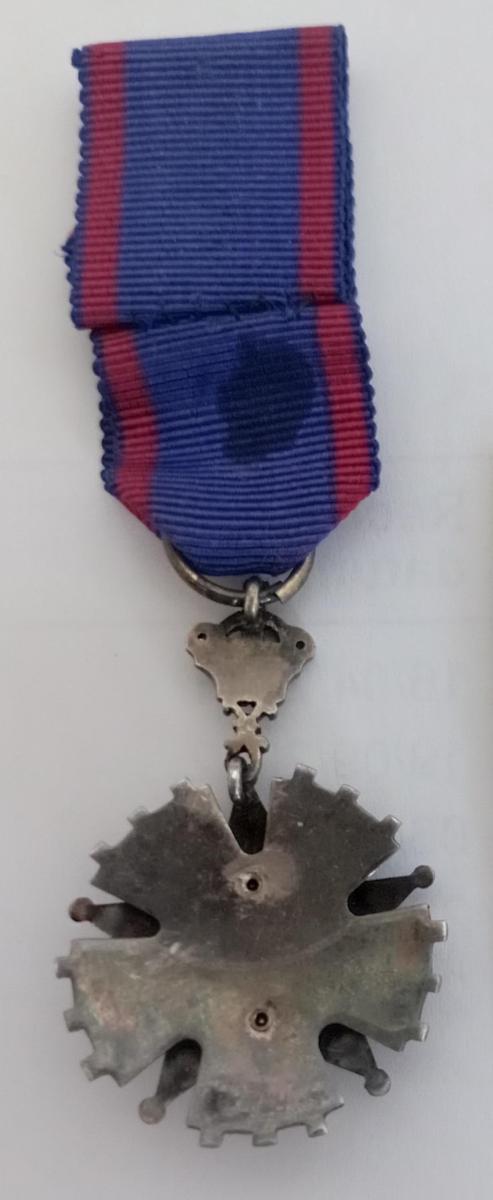
Above are 3 additional lower-resolution images of this same miniature (2 photos of the obverse and 1 of the reverse) from a part of the La Galerie Numismatique website that is no longer available. The obverse images do show that the floral elements on the star arms appear to be silver as is the inscription of "Ismail" on the central boss. They do not show well the red and blue enamel on the crown suspension device.
There are also several differences in the crown suspension device compared with other miniature examples (in addition to the potentially taller height of the crown element). A quite unusual aspect of this miniature is the enamel on the crown suspension. The red enamel is visible in two spaces between the arches (and possibly in each lateral portion although the photo does not make that clear) that may be intended to represent velvet. There also is blue enamel on two round ornamental features of the band around the head opening at the inferior portion. Almost all other examples I have seen photos of don’t have any enamel on the crown suspension. The only exceptions are, again, the miniature of Dr. Ferguson Lees from a 22 June, 2021 auction by Woolley and Wallace, shown in my post on this thread of 23 September, 2021 (4th photo) and the mini Owain illustrated here on GMIC in his post of 11 December, 2017 (1st phot 2nd from R on the upper row) in the thread “Miniature of the Middle East& Arab World that he started on 6 December, 2017. Also except for the Dr. Ferguson Lees mini and Owain’s, all the other crown suspensions shown in good-high resolution images have a different connection to the body of the miniature medal. They connect to the rayed embellishment, not the superior arm as on this example (and the Ferguson Lees mini and Owain’s). One possible explanation is that this mini may have been made by Tewfik Bichay. Although no images of the reverse of either the neck badge or breast star are provided in the listing of the Dr. Ferguson Lees awards, the wreath element in both the neck badge and breast star of the Dr. Ferguson Lee full0-sized awards exhibit the configuration of fruit dots, form and color of the green enamel, and form of the red bands around the wreath that appear distinctive of Tewfik Bichay’s design and execution on pieces with his maker’s hallmark. There are some wreaths of this form on pieces marked with the Lattes name on the reverse. They either represent recent “repairs” that incorporate a Bichay wreath on pieces that are otherwise the product of the Lattes design (there is one sash or neck badge I have documented on this thread that has the a “Bichay-style” wreath that appears oversized on an otherwise probable Lattes badge, see my pedantry about this ). Of course, as the chief artisan in the Lattes workshop, Bichay may have altered the wreath design slightly form it’s original form while still working for Lattes. The intact set of Dr. Ferguson Lees awards offered in the Woolley and Wallace 2021 auction (including award brevets) makes that miniature the only example of an Order of Ismail mini I have seen in my online research that is associated with its original owner. It is reasonable to infer that he may have obtained his complete set of miniature medals contemporaneously with the full-sized awards. Circumstantially, if his 3rd Class Commander award was made by Bichay, it makes the Bichay workshop a reasonable suspect to have slightly modified the more common forms of the miniature Order of Ismail (see the other examples illustrated on this thread in my posts of: 5 December 2017; 10 November, 2018 showing 2 minis in the 1st image; 1 November, 2019 showing 2 minis in the 4th photo; 12 February, 2020showing the obverse & reverse of a mini; 23 March, 2020, Owain’s post of 20 April 2020 showing 2 minis in obverse & reverse views; my post of 22 April 2020 in the 2nd image; Lars post of 23 April 2020 of 2 minis; and my post of 31 October 2020 showing Owain’s illustration from his article (Raw-Rees, Owain, 2018. Egypt, King Farouk and his dress miniatures. Miniature Medals World, No. 130, March) featuring 3 special mini designs of King Farouk, showing one similar Ismail mini in the 2nd-to-last photo).
0 -
Below are moderate-resolution illustrations of a lovely 1st Class Order of Ismail set from a February 13, 2024 auction (Auction 61371) listing by Heritage Auctions, Lot 25616 (https://coins.ha.com/itm/egypt/egypt-kingdom-pair-of-uncertified-order-of-ismail-medals-nd-unc-total-2-/a/61371-25616.s?type=DA-DMC-SixBid-WorldCoins-61371-02122024). Owain alerted me to this auction that also included a very uncommon 50th anniversary commemorative medal of the Egyptian Indigenous Courts (Lot 25230) and a Froment-Meurice Mixed District Courts badge (Lot 25091) that probably belonged to Judge Frédéric Rauret y Sugastres (see my two posts of 26 March, 2024 regarding the 50th anniversary commemorative medal and the Mixed Courts badge on the “Egypt Khedivate Judges Badge question” thread here in the “Middle East & Arab States” section of GMIC). This set includes the sash, sash badge, breast star, case, brevet, and an image of an individual wearing the Order of Ismail breast star (the unnamed awardee?). The auction listing has no photo of the case for this set.

Obverse of the 1st Class Order of Ismail sash badge. Both the sash badge and breast star have been well polished. This shows the normal Lattes form of the wreath. The engraving of the golden floral elements on the five star arms have a single distal mark in the central longest petal of the distal flower and 3 marks on each lateral side of this element. The 2 central flowers each show 3 lateral marks and a longer medial mark oriented to the longest medial petal or the space between that petal and the central petal. The mark in the joint of the 2 middle flowers and the lowermost “bud” element are simple straight vertical engravings, and the flowing marks within the stems and leaves are well-centered and elegantly executed. The Cairo office gold assay mark for 18 k cold and the ibis mark for Egyptian made gold are visible on the right side connection between the superior star arm and the crown element. The weight of the sash badge is given as 40.20 g, no measurement is provided.
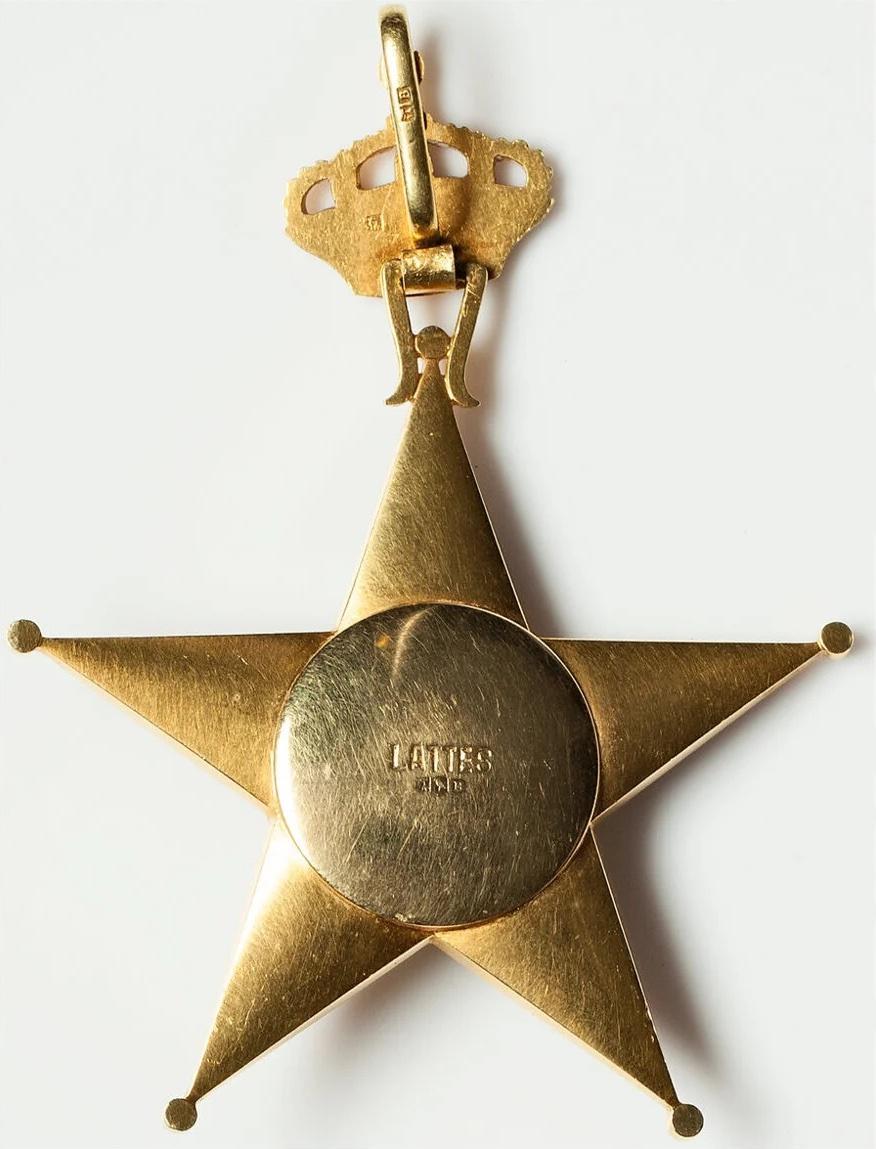
Reverse of the sash badge showing the “LATTES” mark above the 3 Egyptian gold hallmarks. The date hallmark is “B” = 1927-1928. Although the resolution is not good enough to clearly see the hallmarks on the reverse of the crown element, the Cairo office gold assay mark for 18 k gold is visible on the reverse of the crown (to the viewer’s left of the suspension loop) and the loop is marked with the same Cairo office gold assay mark and the date hallmark “B”.

Obverse of the breast star of this same 1st Class set. The enameled wreath also represents the usual Lattes configuration. The engraved makrks on the gold floral elements of the blue enameled star arms show the central mark of the central petal and the three lateral marks on each side. The 2 middle flowers have the most distal mark oriented with the longer medial petal and 3 lateral marks. The marks of the joining point of these middle flowers is a wide horizontal mark and the lowermost bud and is a wider vertical mark than on the sash badge (probably just because the breast star is larger than the sash badge). The flowing marks on the stems and leaves are well-executed with similarly wide flourishes in the curved portions as seen on the sash badge. The weight of the breast star is given as 115.18 g, no measurement of the star’s diameter is provided.
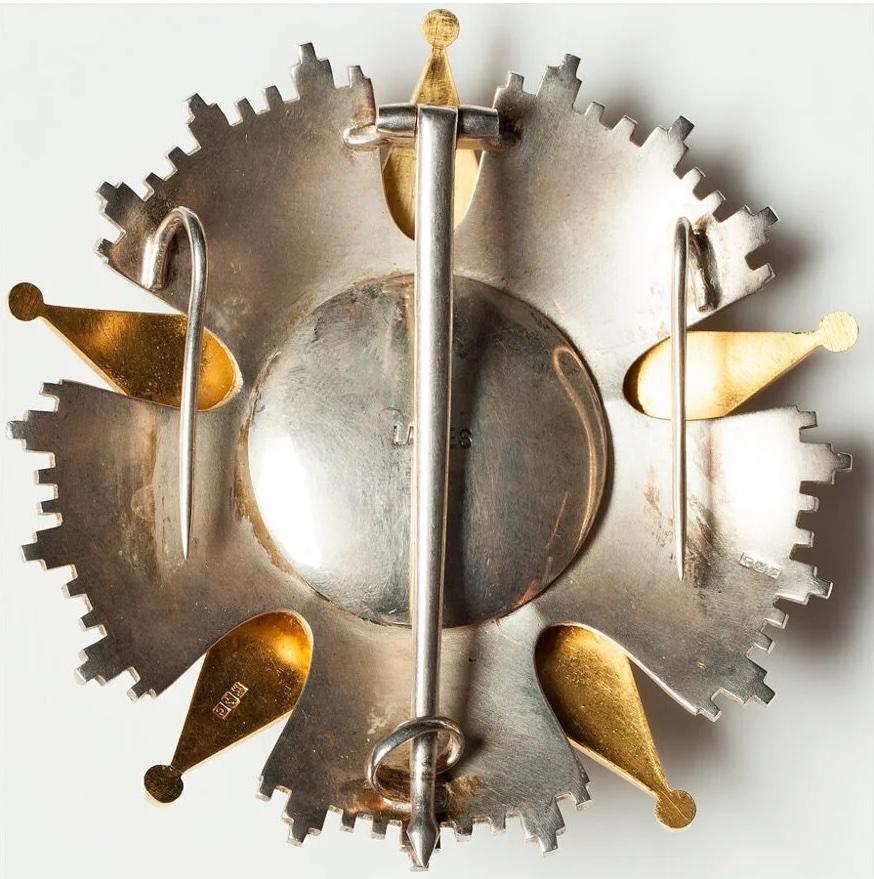
Reverse of the breast star showing the ”LATTES” mark underneath the tunic pin. The 3 Egyptian silver hallmarks are visible oriented to the long central ray of the embellishment on the portion in the ~4:00 position (the Cairo assay office mark for 900 silver, the cat hallmark for pre-1946 Egyptian-made silver, and the date hallmark “C”). The 3 Egyptian gold hallmarks are visible on the reverse of the gold star arm in the ~7:00 position in this reverse view (showing the Cairo assay office mark for 18 k gold, the ibis mark for Egyptian made gold pieces, and the date hallmark “C”). The “C” date hallmark indicates an assay date of 1928-1929.
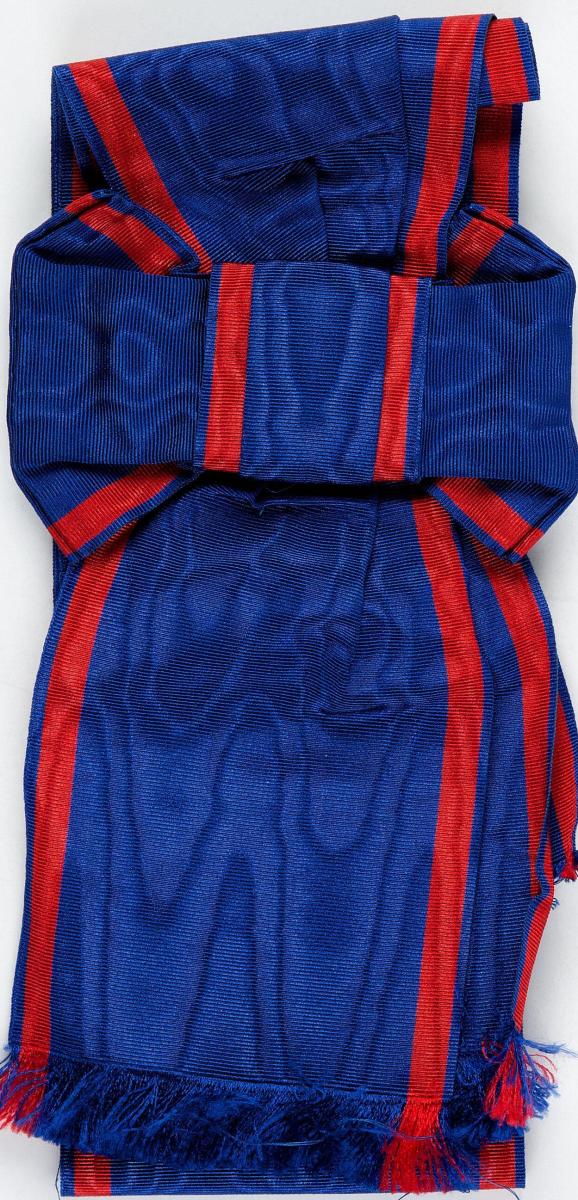
Sash offered with this 1st class set of the Order of Ismail. No pinking (zig-zag cuts that diminish unravelling of the ends of the cloth) is present on the ends of the sash nor on the decorative bow (although the loose ends are not visible).
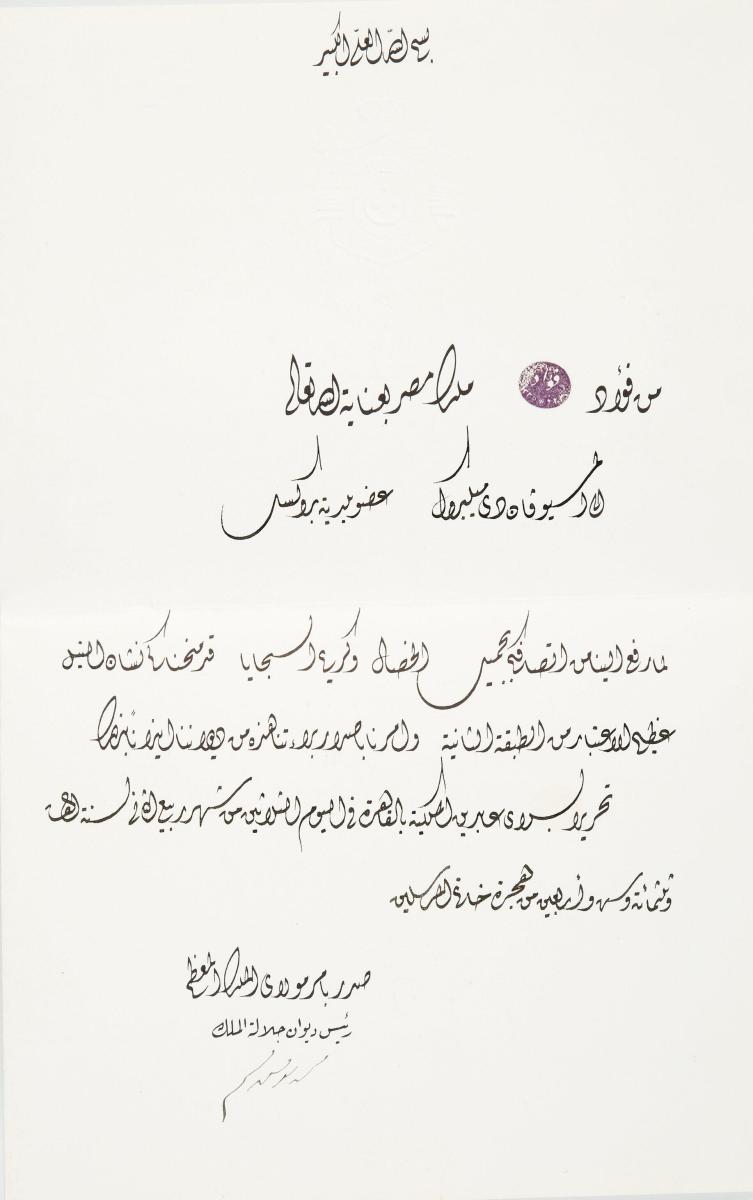
Award brevet offered with this Order of Ismail set. This example lacks the paper embossed design of the breast star of the Order of Ismail that is present on some examples. Perhaps someone could volunteer the name of the awardee on this brevet?
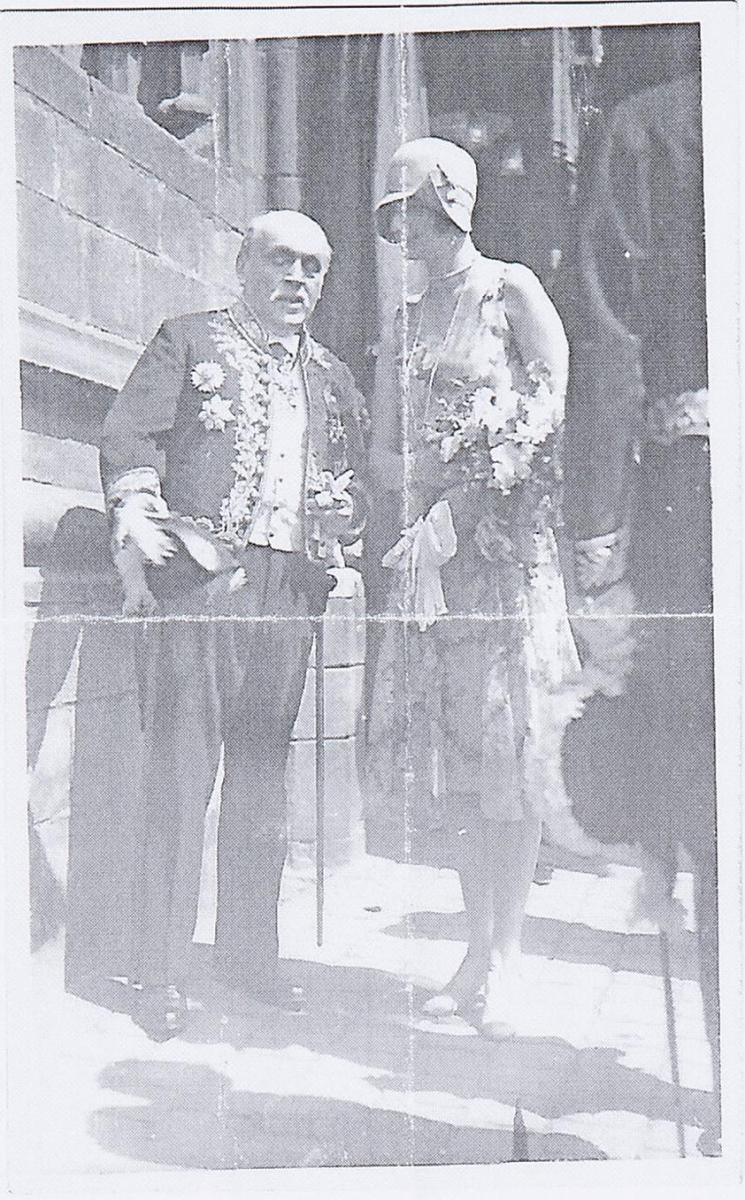
Low-resolution image of an individual (European?) wearing the Order of Ismail breast star visible above another award on the right side of his chest. This image is included in the Heritage Auctions listing for this Order of Ismail set. Some medals on ribbons can be seen, but not distinguished, on the left side of his jacket. He is not wearing a sash and the poor resolution makes it impossible to make out the neck badge he appears to be wearing. This seems to be a photocopy of an image, possible a previously folded newspaper or magazine image. No information is provided about this individual or whether he is the awardee of this Order of Ismail. I am unsure whether the short jacket this man is wearing is part of an Egyptian rank uniform. Does anyone have a suggestion for good references on uniforms for various Egyptian civil or military ranks (i.e., Bey second class, Bey first class, Pasha, Ri'asset, and Imitiaz)? There is a mention of an unspecified book with illustrations of pre-WWII Egyptian civil court uniforms in a post 19 June, 2009 post by TS Allen in the GMIC thread "FLY WHISK-EGYPTIAN BADGE OF OFFICE" started by Mervyn Minton on 12 June, 2009 in the "Great Britain: Militaria: Badges, Uniforms & Equipment" section of the "Great Britain & Commonwealth realms" listings. ChrisW expressed an interest in such a book in his post of 20 June, 2009 on that thread, but no one ever identified the reference.
0 -
Howdy All,
I have sent Magdy Hanafy payment for 3 copies of his book. One copy is already earmarked for EJ, so there are still 2 copies available. Because he selected a wire transfer, my cost for each book is $108 (still below the $150 +$50 shipping thorough Shehabcoin on eBay). He will receive the money after 30 April, when his bank releases it to him. Please send me a personal message (through "Messages" here on GMIC or my email address in my profile) if you wish to get one of the remaining copies and we can arrange the most economical shipping.
Cheers, Rusty
0 -
Antique Arena responded to an email I sent them about the problematic badge shown in my post here of 9 February, 2024. That badge sold for $1100 at auction. I did identify to them why I felt this is a poorly-cast fraudulent badge that could not have been made by Froment-Meurice. Antique Arena wrote me that "After the sale the lot was canceled and the item was returned to the consignor." So, good for them!
0 -
Howdy Jan,
Another colleague in our office is Czech. He has to visit Europe occasionally for his mother's health. She is in Belgium, but on his last trip last year he did go to Prague. She does own an apartment in Prague, and something will have to be done about it in the near future. I will check to see if he may have a trip planned that would make it easier to get a copy of the book to you in the near future. I have 2 conferences I must attend in Köln, Germany and Sevilla, Spain. Maybe there is amore economical way to post the book form one of those locations. Sorry, not an easy solution soon, but I wil keep trying to work on this for you.
Cheers,
Rusty
0 -
I'll have to check on this The price Hanafy quoted is for a bulk purchase of 4 books, all shipped to the same foreign destination.
0 -
The same February 13, 2024 auction by Heritage Auctions as that noted above (Auction 61371) offered a Mixed Courts badge made by Froment Meurice as Lot 25091 (https://coins.ha.com/itm/islamic-dynasties/ottoman-empire/islamic-dynasties-ottoman-empire-silver-judge-s-badge-nd-unc-/a/61371-25091.s?type=notice-winnernotification). This auction also is archived on the CoinArchives webiste as well (https://www.coinarchives.com/w/lotviewer.php?LotID=6772761&AucID=7878&Lot=25091&Val=bbbeaf5979a6dfc22b36228b8a1cfe68). The description identifies the badge as silver, gives a weight of 158.53 g, and gives its approximate dimensions as ~120 x 85 mm. The actual measurements of this badge are 118 x 88 mm. Owain also let me know about this offering by Heritage Auctions.
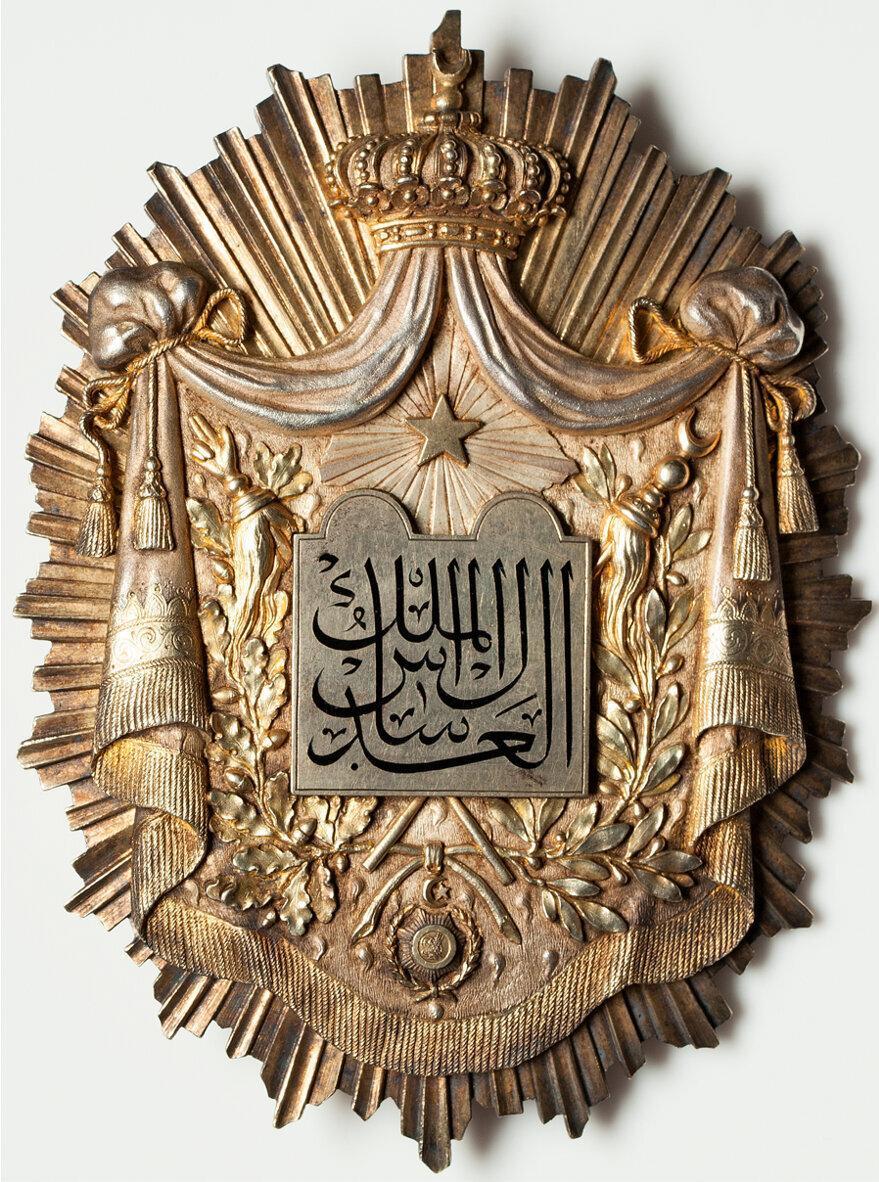
High-resolution image of the obverse of the Heritage Auctions Mixed Courts badge (Lot 25091). This image, and the following photo of the reverse of the badge, are copyrighted by Heritage Auctions (@2023 Heritage Auctions). Although a bit hard to distinguish, this image does show that this is actually a silver and gold District Courts badge. Vermeil can be seen on the rayed embellishment, the fringe of the mantle, the "embroidered" design on the lateral folds of the mantle, the star above the central tablet, the cords and tassels tying each of the upper corners of the mantle, the central crown, each of the oak and laurel branches, the staffs and distal ornaments of the tugs, the small wreath around the Order of Medjidie element, and the central portion and tugra of the Order of Medjidie (also see the last photo in this post).
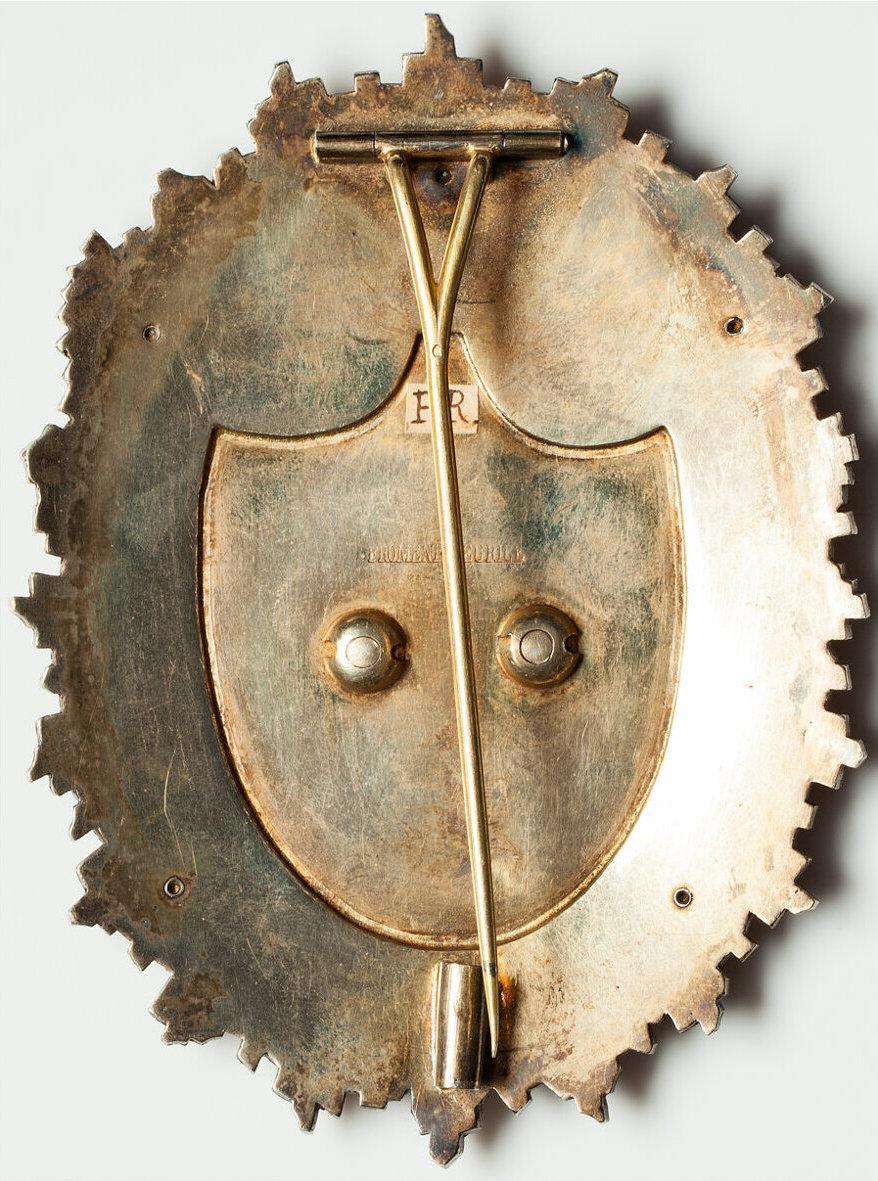
High-resolution image of the reverse of the Heritage Auctions Mixed Courts badge. Note the tag underneath the tunic pin that reads "F.R." on a small handwritten paper tag glued to the reverse, presumably the original owner of this badge. The auction description notes that the associated case has a gilt (?) "F.R." on the outside of the upper lid. The reverse is marked "FROMENT-MEURICE" above the two large rivets, but there is no diamond-shaped hallmark with the rose and Froment-Meurice name on this badge.
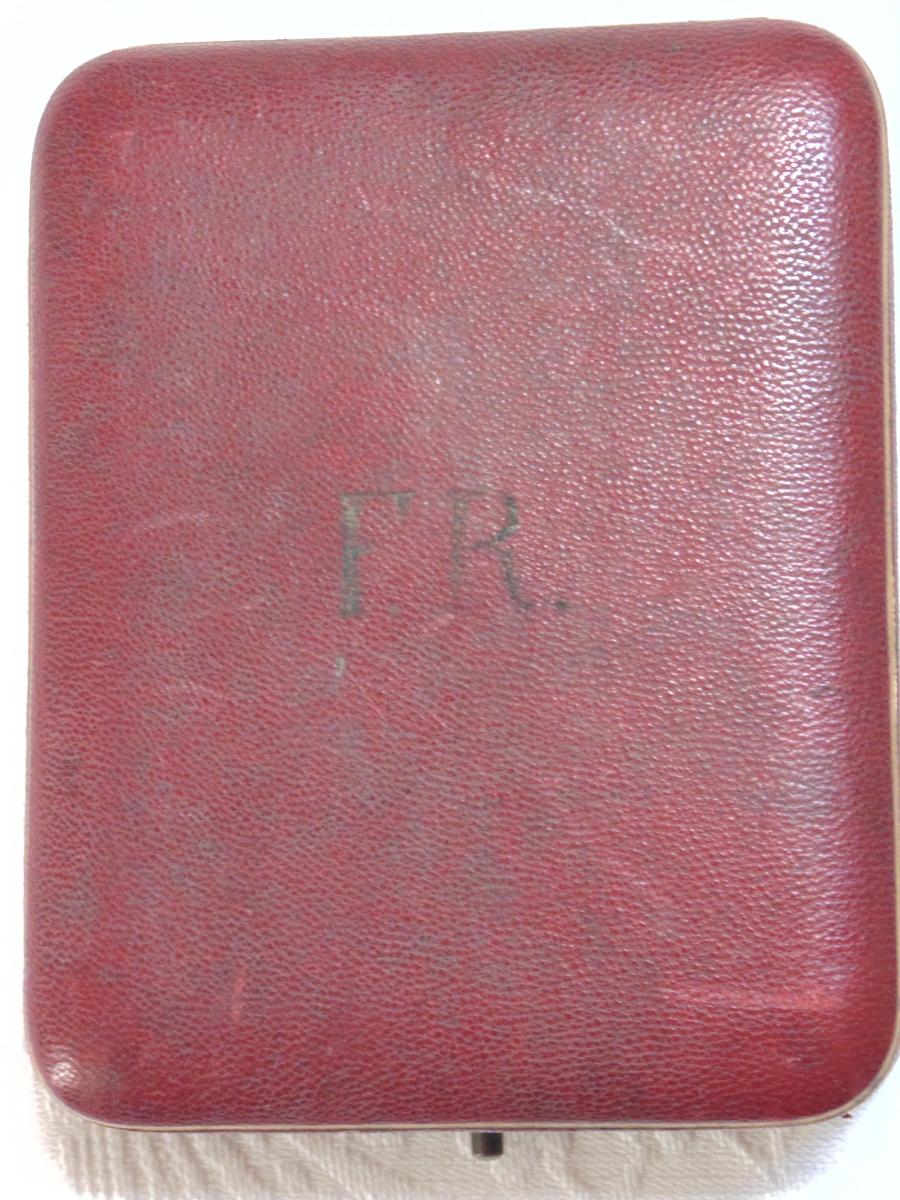
The case for the Heritage Auctions District Courts badge. The name "FROMENT-MEURICE" and the shop address at 372 RUE ST HONORÉ, PARIS' is printed in gold on the maroon satin of the interior case lid, above the red velvet bed for the badge. As noted, the outer upper lid also bears the initials "F.R." as seen on the tag affixed to the reverse of the badge. These initials appear to be written in black ink, not gilt. As this is a gold and silver District Court badge, it could only have belonged to a judge, not one of the other court functionaries who wore silver badges. The only judge I have been able to identify who is represented by these initials is the Spanish Judge Frédéric Rauret y Sugastres. He was known to go by Frédéric Rauret. Judge Rauret y Sugastres was named to the Mansourah District Court on 16 September, 1892, transferred to the District Court of Alexandria in 27 March, 1897, and was decommissioned due to health issues on 31 October, 1904. This places Judge Rauret y Sugastres within the period that Froment-Meurice made badges for the Mixed Courts (1875-1913). As his service on the Courts predates the February 1926 publication of the 50th anniversary volume Les Juridictions Mixtes d'Égypte 1876-1926 Livre d'or Édité sous le Patronage du Conseil de l’Ordre des Avocats á l’Occasion du Cinquantenaire des Tribunaux de la Réforme, par le journal des Tribunaux Mixtes. Alexandrie, Egypte, I am confident there is not another Egyptian or European judge with the F.R. initials who could have been the owner of this badge.
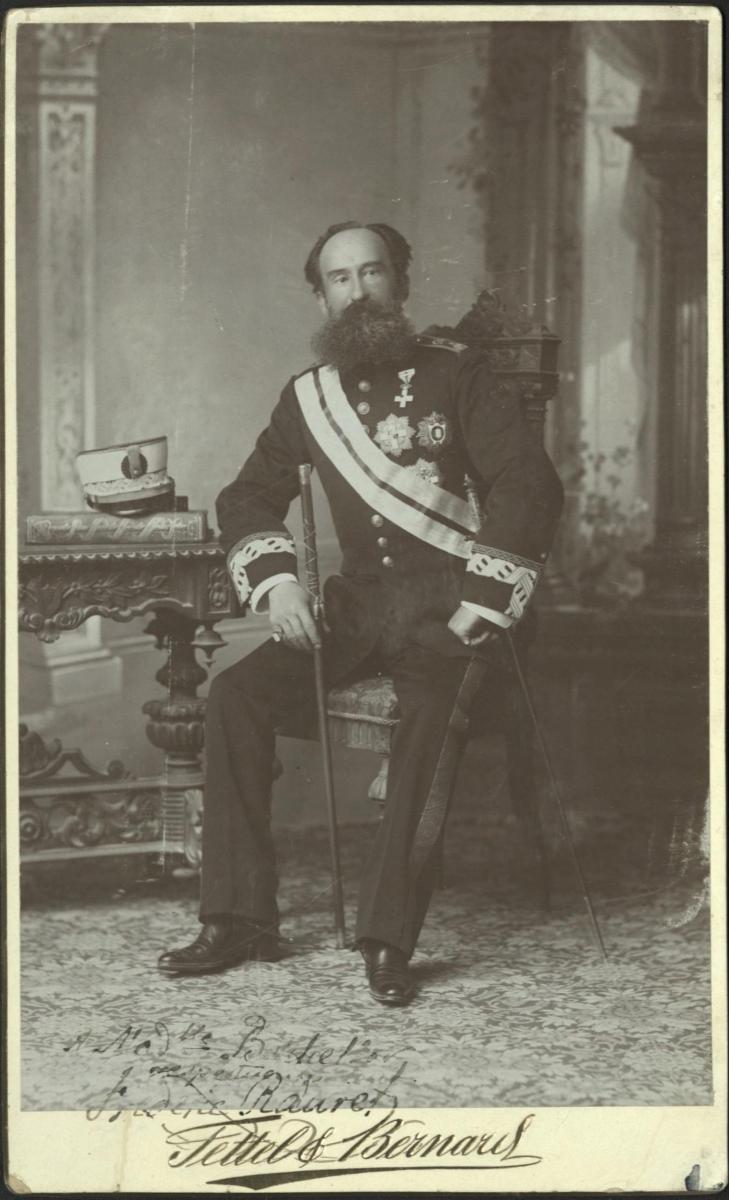
Above is the only photo I have currently found of Judge Frédéric Rauret y Sugastres. This image comes from the George Sherman Batcheller, 1837-1908, Papers, 1825-1943, bulk, 1858-1908 (SC11218), in the New York State Library Manuscripts and Special Collections in Albany, NY, USA. This photo, taken in Egypt at an unspecified date, is curated in Box 10, Folder 27, and is identified as: "Rauret, Frederic (autographed); Photographer: Fettel & Bernard, Alexandria (Egypt)". I do not know what awards Rauret y Sugastres is wearing in this portrait. George Sherman Batcheller was a U.S. Civil War veteran and jurist who was recommended as a U.S. judge to the Egyptian Mixed Courts by President Ulysses S. Grant in 1875. Batcheller was appointed to the District Court in Cairo on 10 November, 1875. He was decommissioned on 30 November, 1885. Batcheller was apparently re-appointed to the Courts in 1898, I am uncertain which Court he served at that time. He was promoted to President of the Appeals Court in 1902. Batcheller died while still technically still working for the Court, but died in Paris in 1908

The reverse of the studio card portrait of Frédéric Rauret y Sugastres identifying the Fettel and Bernard photo studio in Alexandria (New York State Library Manuscripts and Special Collections in Albany, NY, USA. This photo is in Box 10, Folder 27).
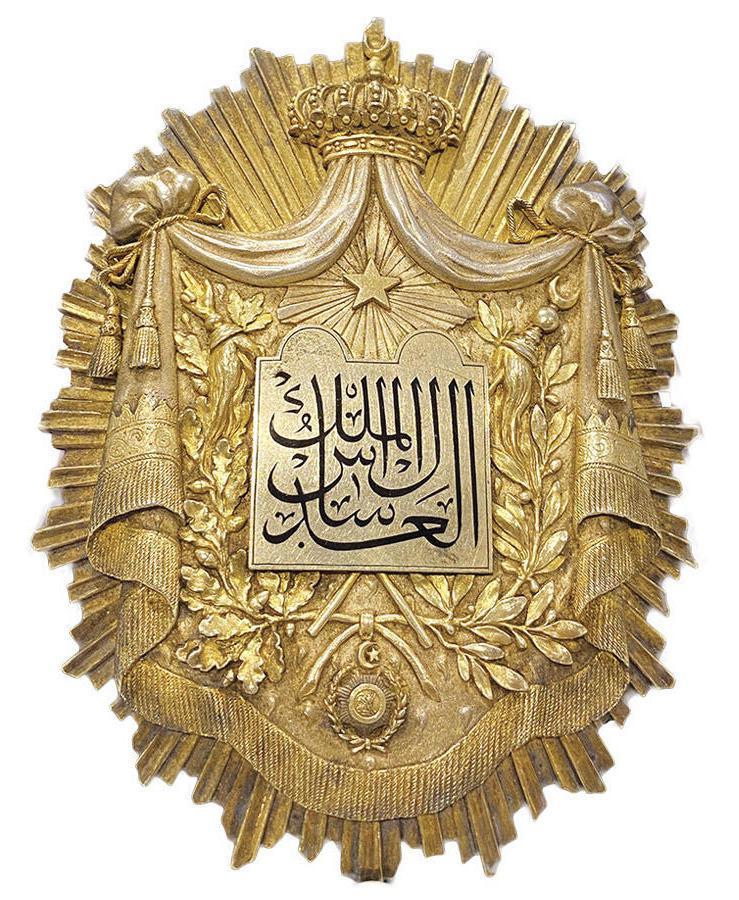
The Heritage Auctions Mixed Courts badge was previously sold on 15 October, 2022 by Editions V. Gadoury, Auction 2022, Lot 225, archived on the NumisBids website (https://www.numisbids.com/n.php?p=lot&sid=6035&lot=225). The Gadoury auction illustrated the obverse of this badge (above in a moderate-resolution image) and provided a photo of it in the case (below), there is no image of the reverse of the badge. I previously included both of these Gadoury auction photos as the first two images in my post of 22 September, 2022 on this thread. No mention is made in the Gadoury description of the initials "F.R." on the case nor on the reverse of the badge.
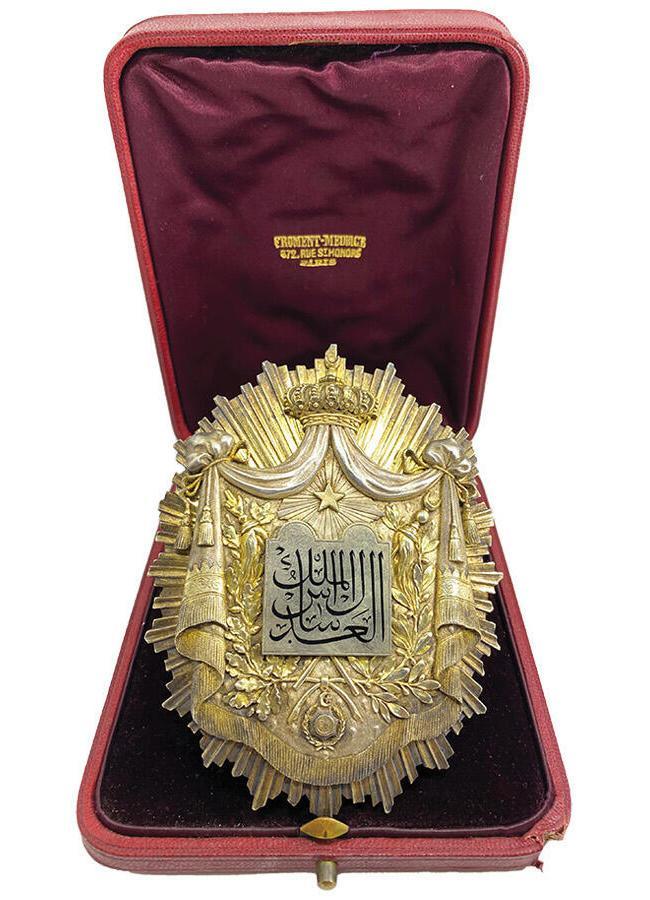
Moderate-resolution image of the the Gadoury Auction offering of the same Froment Meurice badge that belonged to Spanish Judge Frédéric Rauret y Sugastres. The distinctions between the silver parts of the badge design and those that are gilt are a bit better defined in the above photo. This image shows the noted damage to the front lower right corner of the case from impact with a right-angled item.

Above is a moderate-resolution image of the Heritage Auctions Mixed Courts badge from Auction 61371, Lot 25091. This is a post-auction image that shows well the contrast between the silver and vermeil (gold) in the decoration of this badge. The gilt components on Froment-Meurice District Court badges are different on some other examples. On some badges, the central tablet and the rays around the star are also gilt, a few have the rayed embellishment around the Order of Medjidie gilt, and on a couple the "embroidery" design on the lateral mantle folds are not gilt, some show no vermeil on the oak and laurel branches, or the tugs. There are also differences in which portions of the design are gilt on District Courts badges by other manufacturers.
0 -
Below are high-resolution images of the commemorative medal celebrating 50 years of the revised Indigenous Courts in Egypt. I believe this "National", or "Indigenous", Court replaced the former Sharia Law Court and was part of the modernization of Egypt using the French legal code as the basis of law, including the creation of the Egyptian Mixed Courts (replacing the Consular Courts for foreigners) in 1875. I first illustrated an example of this commemorative medal in my post of 27 May, 2022 showing a Horovitz-made Mixed Court badge on a Facebook page of Charmy Photographic. Owain identified the badge and provided an illustration of it in his post on this thread of 28 May, 2022. The photos below are from a 13 February, 2024 auction (#61371, Lot 25230) by Heritage Auctions (https://coins.ha.com/itm/egypt/egypt-fuad-i-gilt-silver-judicial-justice-50th-anniversary-of-the-national-court-medal-1933-dated-unc-/a/61371-25230.s?type=DA-DMC-SixBid-WorldCoins-61371-02122024). Photos, and the description, from this auction also are archived on sixbid.com website (https://www.sixbid.com/en/heritage-auctions-inc/11548/egypt/10066052/fuad-i-gilt-silver-judicial-justice?term&orderCol=lot_number&orderDirection=asc&priceFrom&displayMode=large&auctionSessions=&sidebarIsSticky=false). All three of these images are copyrighted by Heritage Auctions (©2023 Heritage Auctions). Owain brought this auction to my notice, and deserves credit for seeing this offering of an uncommon medal.

High-resolution image of the obverse of this medal commemorating 50 years of the Indigenous Courts 1883-1933. In his identification of the medal, Owain felt that the bust of King Fuad 1 represented the obverse. The additional illustration of this medal I reported and illustrated in my post of 31 May, 2022 on this thread (from from pg 337 of Volume 2 of the 1937 publication of the civil codes: I Al-Kitab al-dhahabi l’il-mahakim al-ahliya, 1883-1933. Al-Matba’a al-Amiriyya bu Bulaq, The Golden Book of Civil Courts 1883-1933, published by the Government press [Amiri Press] in Bulaq) shows the pin on the ribbon visible on the face with Fuad's bust. The ribbon in the first illustration I posted of this with the Mixed District Courts badge shows no pin on the face with the royal coat-of-arms with the inscription on either side reading "50th Anniversary of the National (Indigenous) Court"scales of justice, bracketed by the dates 1883-1933, and the motto "Just is the Foundation of Kingship/Governance". These two Heritage Auctions photos also help identify the obverse and reverse of this medal.

Reverse of the 50th Anniversary Commemorative medal celebrating 50 years of the Indigenous Courts. As in the publication page shown in my post of 31 May 2022 on this thread, this shows the pin on the ribbon on the face with the bust of King Fuad I. The Heritage Auctions listing identifies the diameter as 42 mm and the weight as 49.24 g. The auction listing identifies the material as gilt silver, however it seems unlikely these medals were gilt and are probably silver with the green enamel. No manufacturer of this commemorative medal has been identified in what literature I have been able to consult.
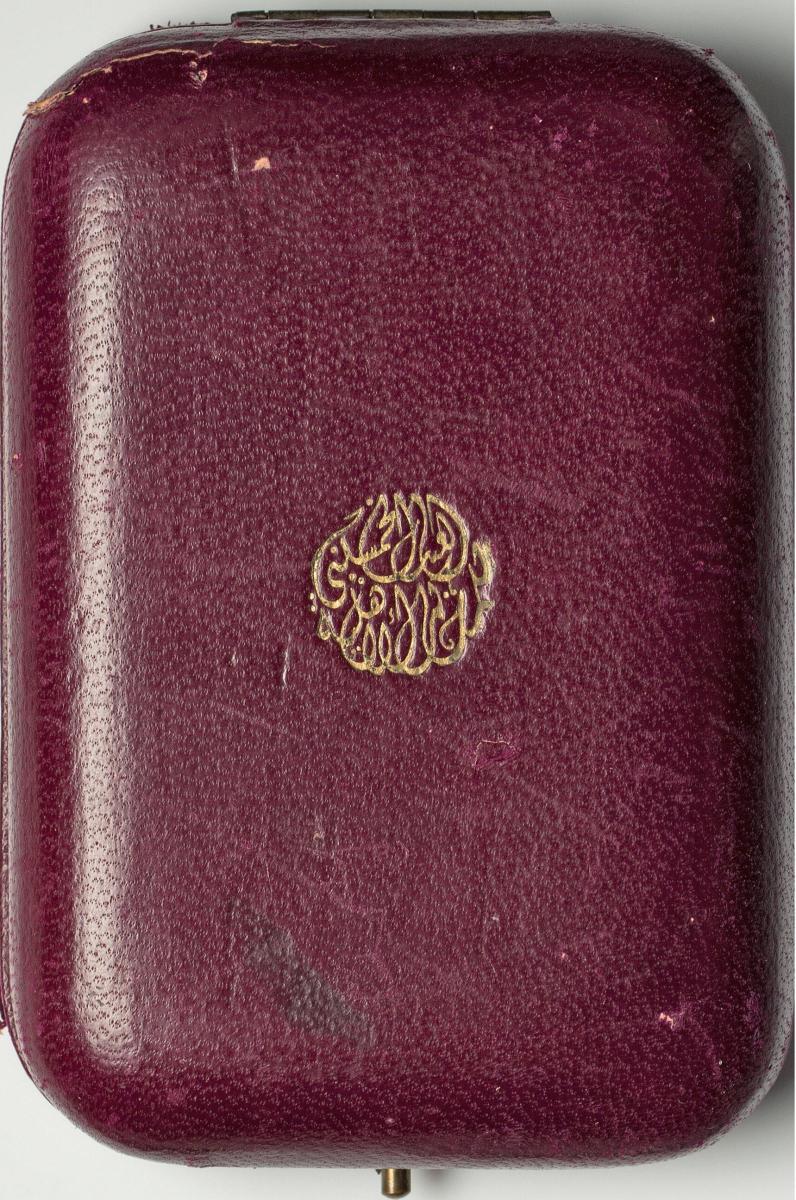
The Heritage Auctions listing included a photo of the case lid for this medal (but this illustration is not on the Sixbid Archive of this listing). The lid has the cipher for Sultan Ahmad Fuad of Egypt that he used between 1917-1922. Afterwards, he became King Fuad I following the British announcement of "semi-independence" of Egypt from the Ottoman Empire but under continued practices essentially identical to the "protectorship" of Britain from 1882-1922.
0 -
The staff member from my office was unable to meet with Mandy Hanafy. There are 2 current options. We can wait until October, and my staff member will be back in Cairo and get 4 books for $90 each. Or, I can order now and have 4 copies shipped to the US for $100 each. One person is willing to pay $100 and get a copy soon (with a caveat about better packaging than the eBay seller employed). Please let me know if anyone else interested in a copy has a preference.
0 -
Howdy Jan, Congratulations on getting this breast star! These are the 3 Egyptian assay hallmarks. The leftmost is the mark of the Cairo Assay Office purity mark for silver = 900 silver (90%); the center mark is a cat, indicating Egyptian-made silver (used between 1916-1946); the final mark on the right is a date hallmark, "B" = an assay date of 1927-1928.
0 -
I am arranging the purchase of 4 copies of Magdy Hanafy's books. One of my staff members is in Cairo until this Friday. I still do not know the precise discount of the book.
0 -
Magdy Hanafy has not yet identified a price to me, it depends on how many books are purchased. I have a colleague in Cairo now who is willing to carry a few books home. That also would reduce the price per book. I am checking when she returns to the US.
0 -
Howdy All,
Magdy Hanafy just contacted me. He has not indicated the price of the book through him, but I will contact him tomorrow. I know that many of you who are interested in the volume have have already purchased them through Shebabcoin on eBay. If anyone still would be interested in trying to put in an order with the author, please let me know, and I will check back with you once I know the price.
Cheers, Rusty
0 -
Owain is of course completely correct, it is all the proper configuration. If the seller provides a measurement, 70 mm diameter is a 2nd Class breast star and 80 mm is a 1st Class breast star. A 2nd class neck badge & breast star (without the ribbon for the neck badge) with attribution to a specific individual sold in 2021 for 4500 Euros. a 1st Class breast star without the sash badge, sash, or case, ands with enamel damage to one arm, was estimated to fetch 500-800 GBP in March 2023.
0 -
still no reply from Magdy Hanafy
0 -
Interestingly (although depressing), a badge like the one I recently illustrated in my post here of 16 January, 2024 that was offered by a jeweler in Cairo, Egypt was just sold at a 16 December, 2023 auction (Lot 0165) by Antique Arena Inc. in Brooklyn, NY. The listing is archived on the liveauctioneers website (https://www.liveauctioneers.com/item/166660205_antique-egyptian-suez-canal-grand-insignia-of-a-judge). High-resolution photos were included in that listing, identifying this as an “Antique Egyptian Suez Canal Grand Insignia of a Judge”. Its’ materials are stated to be silver and vermeil. The dimensions are given as approximately 3 7/8 x 2 3/4 in (98.425 x 69.85 mm) and it weighs 112 g. The size of this badge is too small compared with the sizes of Froment-Meurice badges and the similarly larger sizes of badges made by all other makers as well (Rudolf Stobbe, Wolf Horovitz, Zivy Frères & Cie., D. Ialanos, A. de Leo & A. Kassandrinos, and including badges representing 4 additional as yet unidentified manufacturers). Most authentic badges range between 112-118 mm in height and 85-90 mm in width. The smaller size of the Antique Arena example also results in the much lighter weight of this badge. All badges for which weights have been published in auction descriptions range between 141.76 to 173.05 g, with a single heavier outlier of a Zivy Frères vermeil badge at 290 g. I have included below 3 photos that show the supposed “FROMENT-MEURICE” maker’s mark on the reverse of the Antique Arena badge that also is anomalous. In my previous 16 January post I suggested the rayed embellishment on that badge might be original. However, I obviously did not look at the lack of rivets in the photo provided, and maybe the angle makes it less clear that the proportions of the maker's name to the overall badge size were odd. The measurements in the Antique Arena description and the photographs show this is a solid cast piece lacking the 3-part construction seen on all other Mixed Courts badges. There are many examples of the workmanship of Maison Froment-Meurice who originally designed this insignia for the Mixed Courts. They represent the highest quality examples of these badges. As with the piece I illustrated above in my post of 16 January, the execution of all aspects of this Antique Arena badge is quite odd and glaringly inconsistent compared with any other bonafide examples of the Mixed Courts badges by Froment-Meurice or any other manufacturer. The attribution to Maison Froment-Meurice is impossible because of the large number of anomalous design and execution differences compared with the many online images of unquestionable examples of that maker’s work. These images are of higher quality than those I received from Egypt and allow comparisons of the details of this faked badge with other examples on this thread. The appearance of this example and that from Egypt makes me suspect recent work by someone getting at least of a few of these poor copies onto the market.
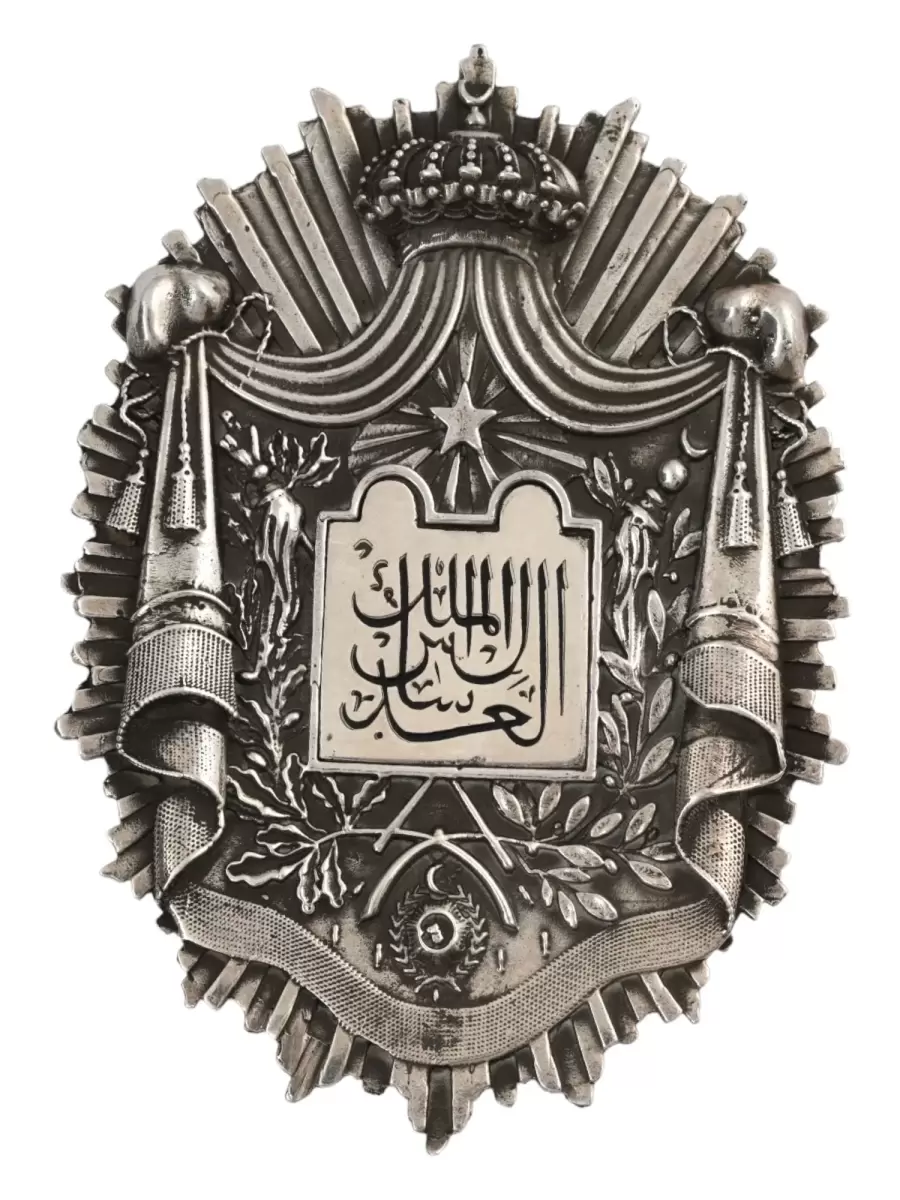
Above is a high-resolution image of the obverse of the Antique Arena badge showing clearly the many anomalous design elements and workmanship of this badges. The image can be zoomed for more unpleasant surprises. The obverse of this badge exhibits many casting defects such as pinholes, misruns (i.e., the medial cord on the left tassel attachment to the mantle corner, and the cord on the medial tassel on the right corner), flash, and vein defects, unambiguously indicating it is not struck. The inconsistencies in design and workmanship compared with real Froment-Meurice made regalia that I noted in my 16 January 20204 post are much more evident in this high-resolution image. As I do not believe this badge is authentic, I am uninterested in cataloguing the design and manufacturing anomalies. I no longer think the central tablet may be original, but the calligraphy is copied from an uncommon form seen on 5 unmarked badges shown in this thread that are not identified yet with any manufacturer. I will confirm that there is no texturing indicating fur on the interior of the mantle, the ermine tails are mere lozenge suggestions, the “fringe” on the mantle is only executed as texture dots (as are the tassels) rather than as detailed yarns, the frame around the central tablet is unevenly and poorly executed, and the "tugra" inside the Order of Medjidie element is a shapeless excrescence.
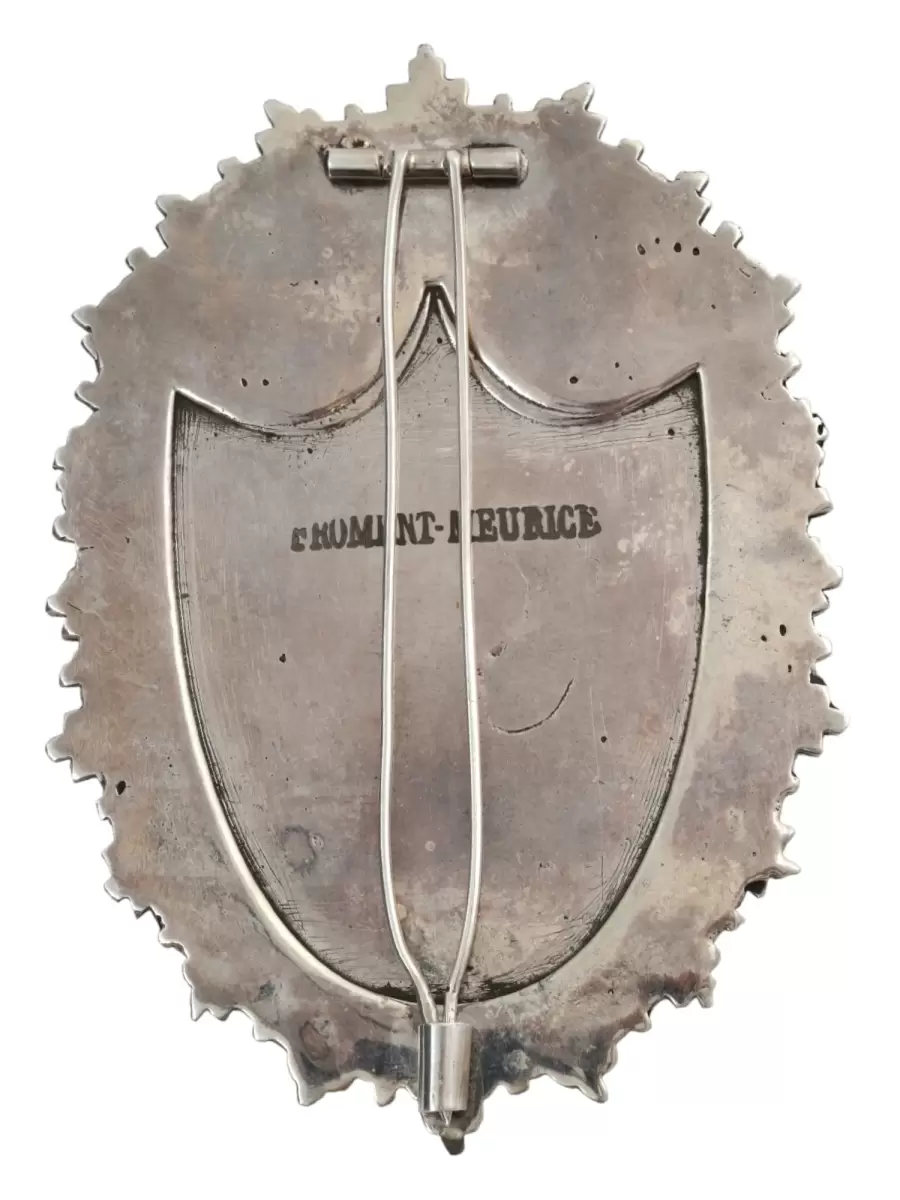
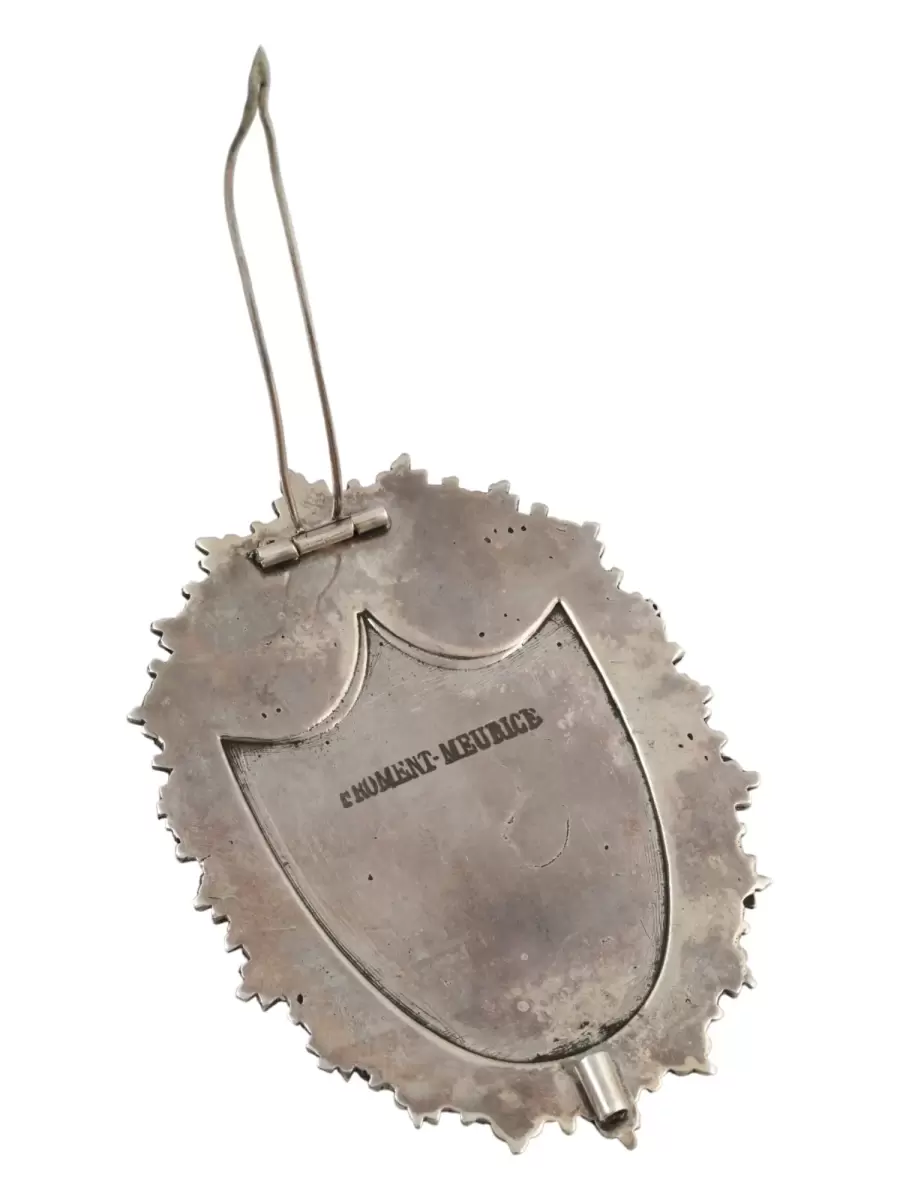
Above are two high-resolution photos of the reverse of the Antique Arena badge that also shows several aspects of the workmanship that indicates this is not an authentic Froment-Meurice badge. One of the most glaring anomalies is the proportion of the “FROMENT-MEURICE” mark on the reverse to the overall badge size. This mark is clearly too large compared with the proportions of the maker’s marks on genuine Froment-Meurice badges. Note the lack of rivets that hold the 3-part construction in place on authentic FM badges, and used by all other makers. Additionally, small defects (blowholes, pinholes, veins, and possibly flash) can be seen that also indicate this badge was cast. While a cast Mixed Courts badge I came across online made me initially suspect it was a more recent copy, the appearance of a second with its case marked with the manufacturer made me change my mind that it was likely the work of a manufacturer (Union de Graveurs, D. Ialanos, A. de Leo & A. Kassandrinos, Alexandria) producing a more economical badge for judges and other court officials (see my post of 3 February, 2022). Those 2 cast badges do exhibit rivets holding the 3-piece construction together, and a higher level of craftsmanship than is evident on the Antique Arena badge. In this case, the attempt to mark a cast badge as the work of Froment-Meurice with such glaring design inconsistencies is clearly just fraud.
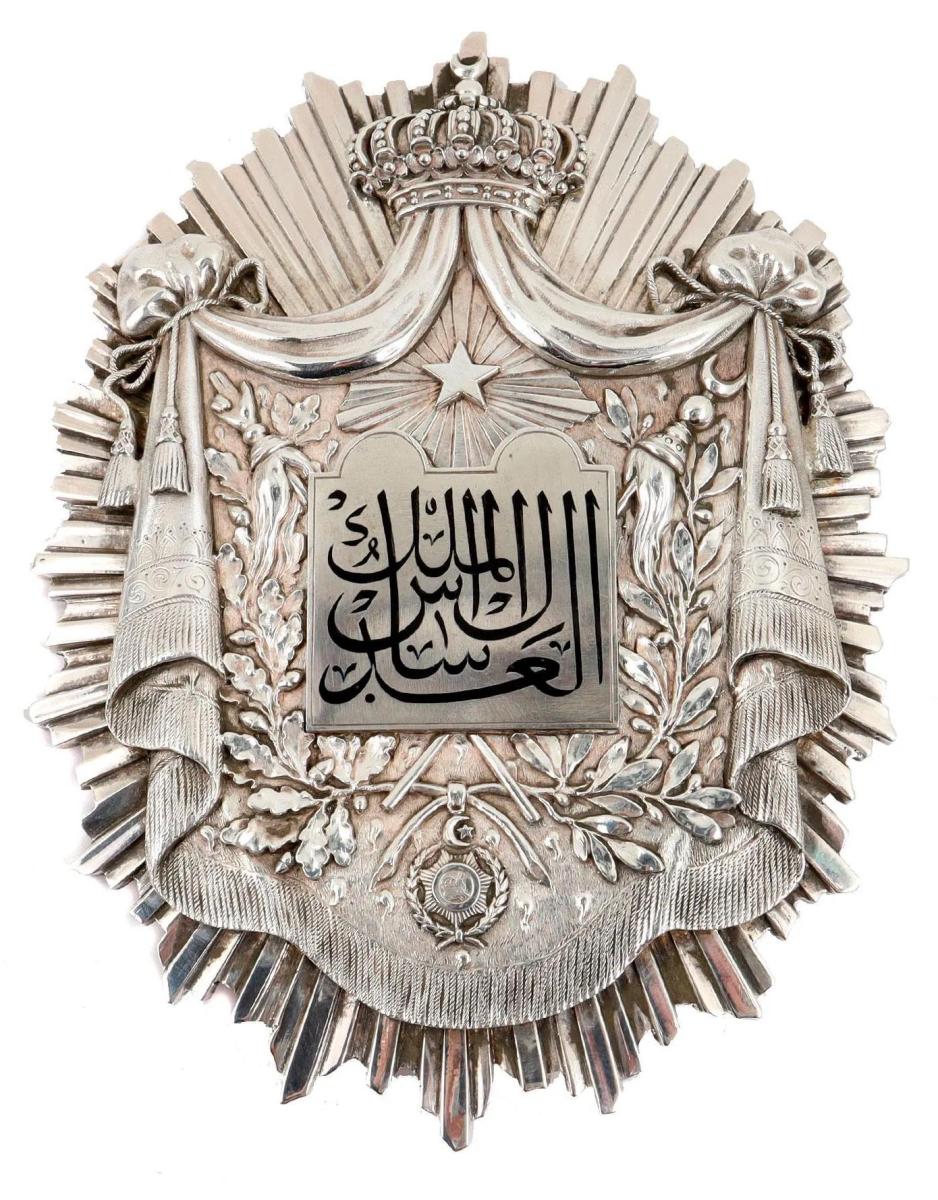
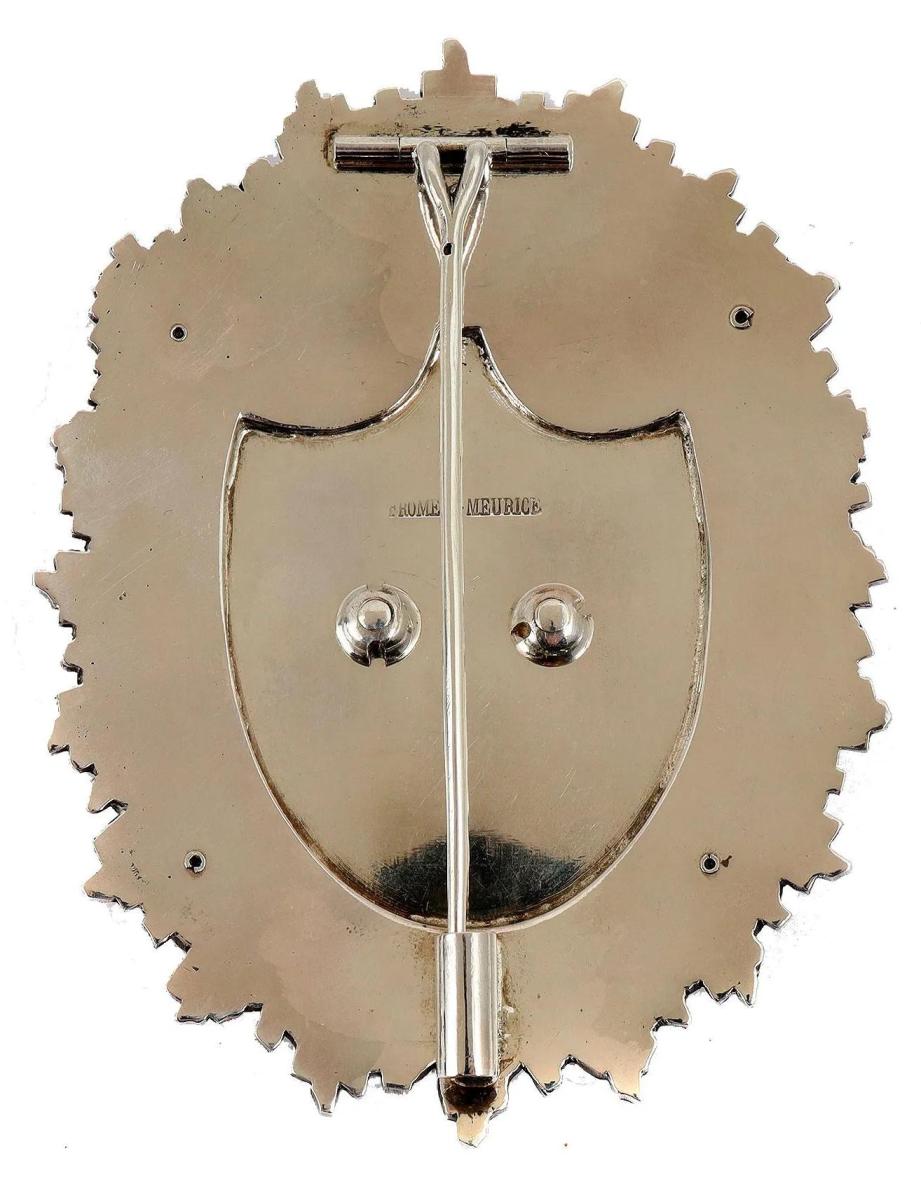
For comparison within this post, above are high-resolution images of the obverse and reverse of an authentic Émile Froment-Meurice badge. This example is from a 19 June, 2022 auction by Helios Auctions (Auction #33). This is a cropped version of the copyrighted image on the invaluable.com website (https://www.invaluable.com/auction-lot/a-rare-ottoman-empire-egypt-judges-badge-by-frome-2d040dba00, ©Invaluable LLC.), the listing is also archived on the liveauctioneers.com website (https://www.liveauctioneers.com/item/130336279_a-rare-ottoman-empire-egypt-judge-s-badge-by-froment-meurice). I previously illustrated and described this badge in my post on this thread of 19 June, 2022.
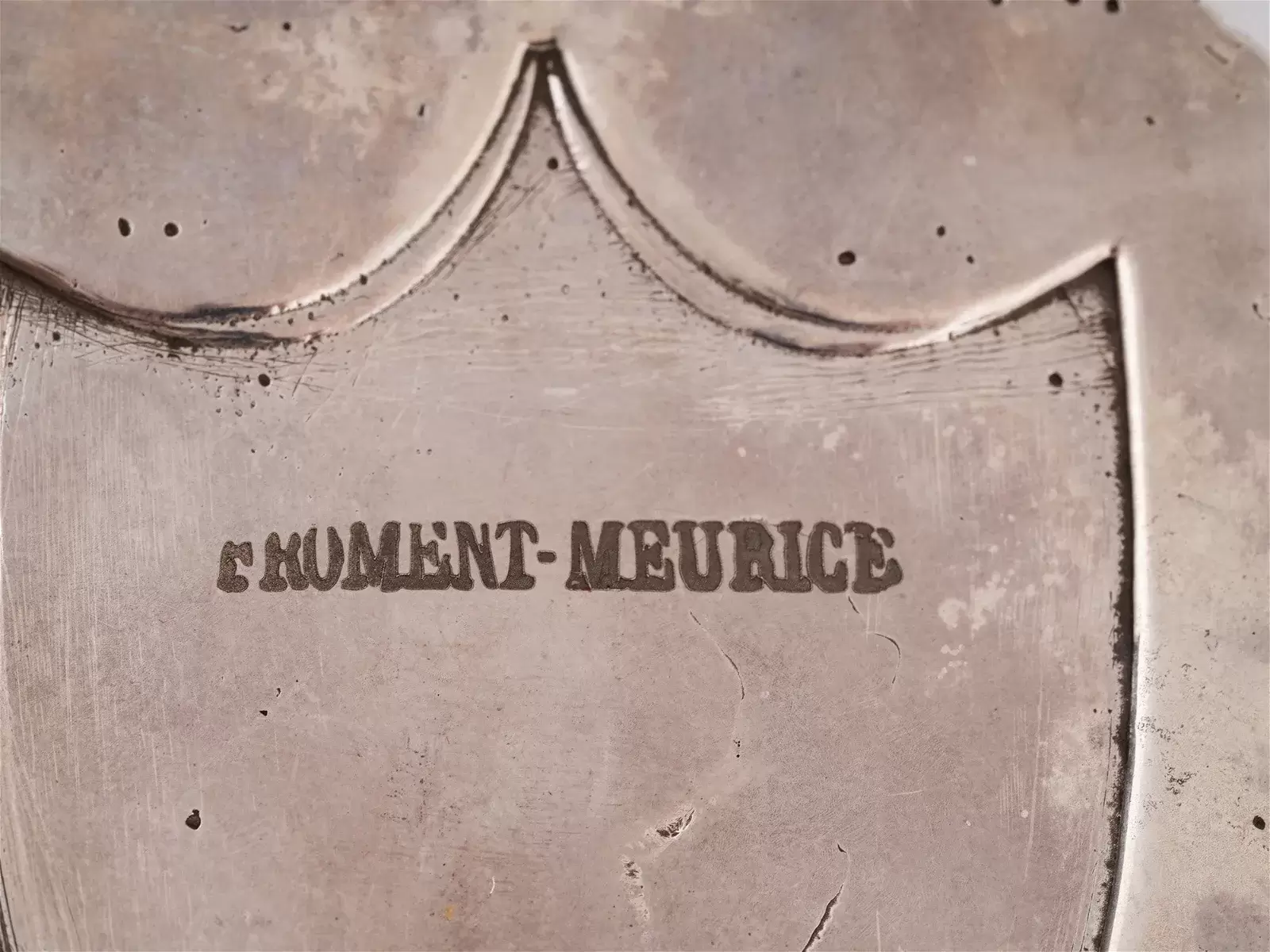
Close-up of the stamped lettering of the alleged “FROMENT-MEURICE” maker’s mark on the Antique Arena badge. This shows forms of the letters that are much less carefully executed than those punched on genuine badges from that atelier. It is common for there to be variability in punches as they wear out and new ones are made, so that maker’s marks will show slight differences. However, this appears to be an example of a less carefully made punch that has thicker letters and greater crowding of several letters than seen on genuine examples. In addition to many visible blowholes and pinholes, this photo shows vein defects from casting, running downward from between the “EU”, and between the “CE” in “MEURICE”. Also note the parallel scratches in the margins of the recessed panel, possibly representing removal of flash or to make this piece appear more worn (also visible in the other 2 images of the reverse of the Antique Arena badge shown above).
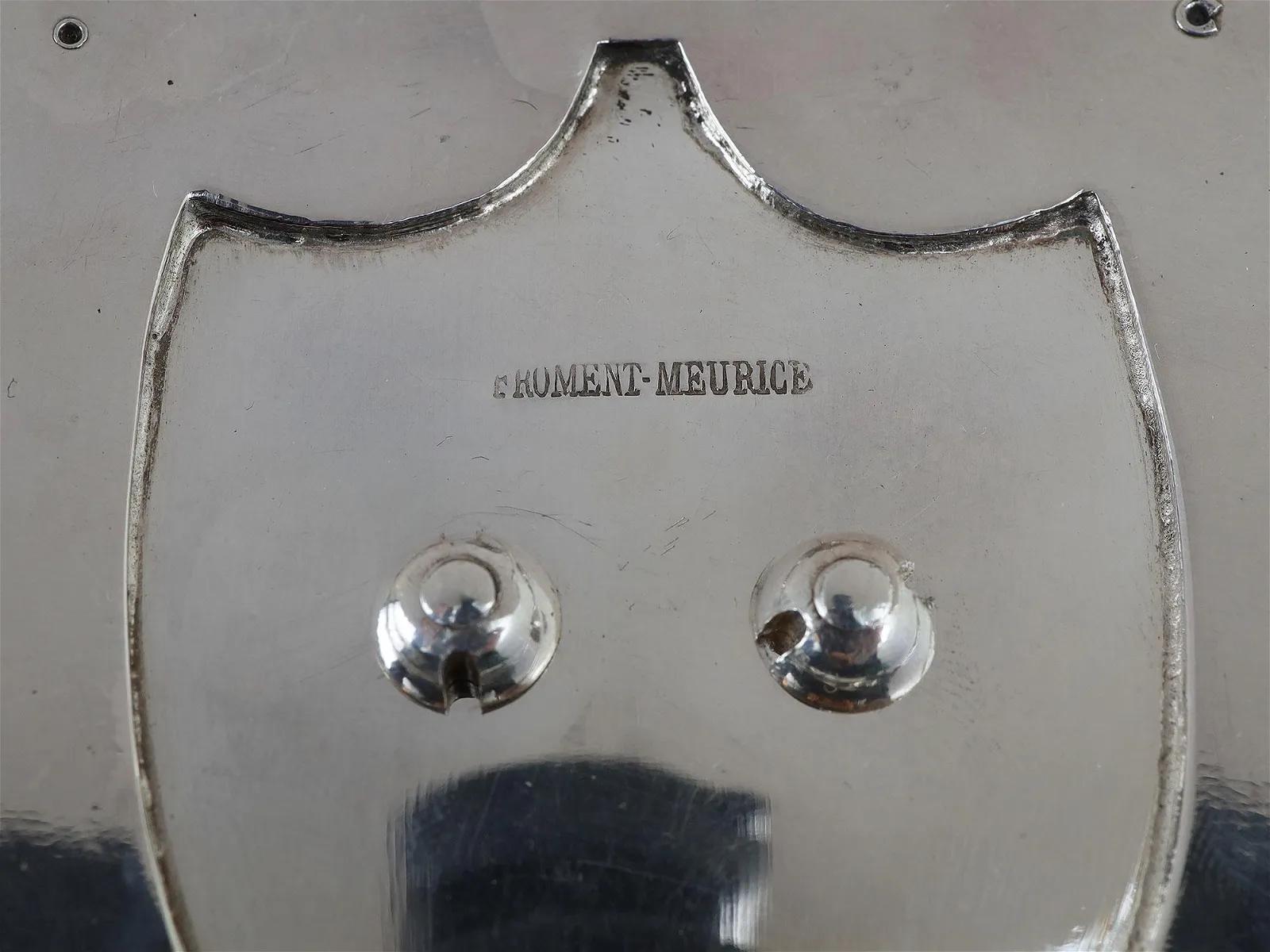
Above is a high-resolution image of the reverse of the badge from the 19 June, 2022 auction by Helios Auctions showing the "FROMENT-MEURICE" maker's mark on a genuine badge. This image can be zoomed for comparison with the Antique Arena badge's reverse. The letters are crisper and less crowded than shown on the Antique Arena example.
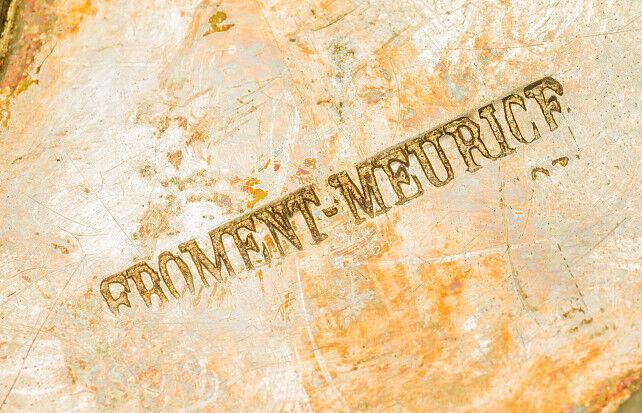
Above is another example of an authentic Froment-Meurice mark, showing normal variation representing different wear on punches and imperfect or idiosyncratic strikes. (From an unsold example that has been offered on eBay for many years for a very high price and with some damage to the enamel on the central tablet inscription: https://www.ebay.com/itm/324752955655).

Above is an alternate form of the maker’s mark on a genuine Froment-Meurice badge. Several Badges exhibit a lower placement of the “FROMENT-MEURICE” mark below the two large rivets and the diamond-shaped symbol with the Froment-Meurice name and a central rose. From a badge attributed to a Greek official (judge?) with the Mixed Courts, Apostolo N. Gennaropolou, from an archived listing on the WorthPoint website of a 2014 eBay offering (https://www.worthpoint.com/worthopedia/ottoman-empire-egypt-khedivate-judges-982926374).
0 -
Thanks for the expert review Owain! I'm still trying to get a response from the author to see about any other source for this volume besides eBay.
0 -
Here is an English language news story about the announcement, almost all of this is already in Chris's post: https://www.elasemawelnas.com/egypt/a-draft-law-to-create-the-great-builder-medal-in-egypt-what-are-its-details-and-financial-rewards/
0 -
I recently saw that the Smithsonian National Museum of American History in the US has completed conservation efforts on the 1st Class Grand Cordon set of the Order of Ismail in their collection. I illustrated this set in the first 8 photos of my post of 19 November, 2022. Among the many good things about this, the sash has been removed from its formerly stapled position on what was likely non-acid free backing. This was part of a general conservation effort made for all the Grand Cross Orders in the Museum collection (Work and Industry: National Numismatic Collection, Grand Cross Orders of Knighthood), removing staples from all of the sashes that had been so rudely prepared previously.
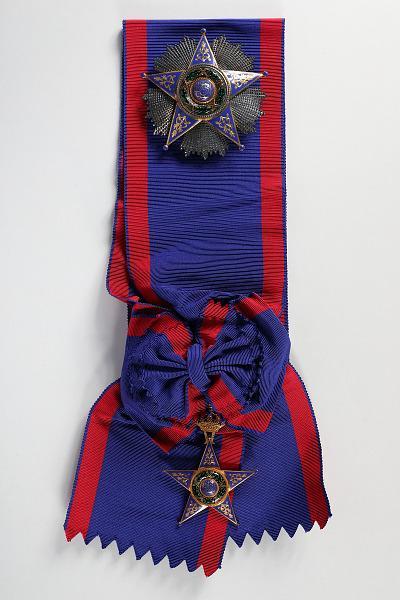
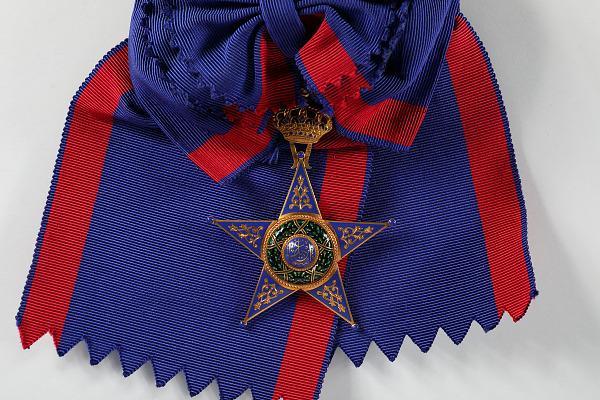
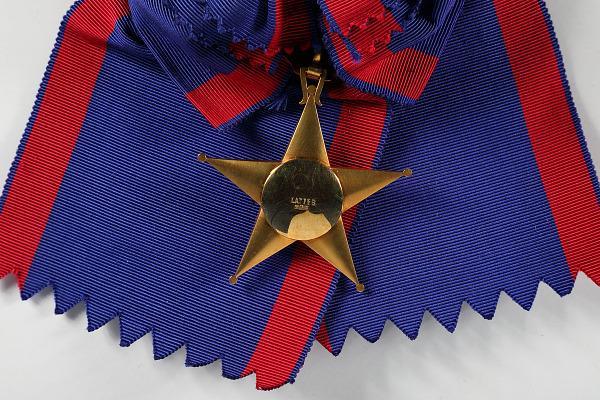
The above 3 images are the moderate-resolution photos on the new NMAH website listing of this holding (https://americanhistory.si.edu/collections/nmah_963004). These images can be enlarged for some additional details, however, those below are much higher-resolution. All images in this post can be used for personal research, but not for publication without permission of the NMAH (©National Museum of American History). During the photographic documentation of these objects, the NMAH staff gave the items slightly new catalogue numbers. 67.94487a identifies the sash and sash badge and 67.94487b is assigned to the breast star. As noted in my original 19 November, 2022 post, the assay date hallmarks on both the sash badge and breast star are “A” for 1925-1926. Currently, the recipient of this award is still unknown.
Below are the high-resolution photos I was just sent from the NMAH staff. They provide much greater detail than the above photos. These images may be used for personal research, but again not for any publications or commercial use.
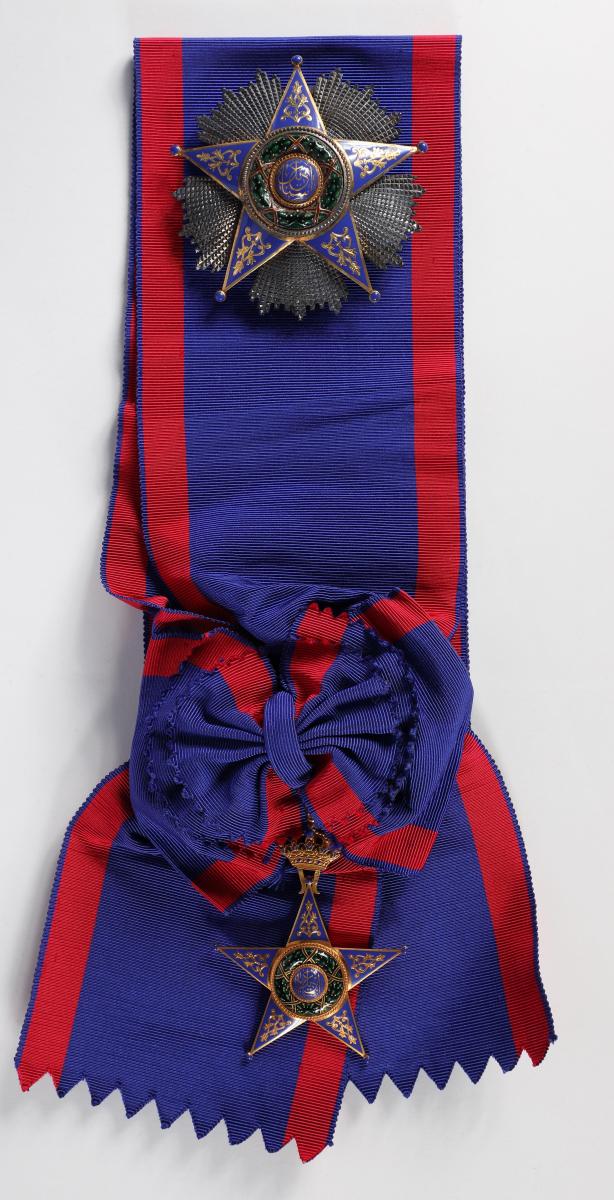
High-resolution image of the NMAH sash & sash badge (Catalogue number 67.94487a) and breast star (Catalogue numbers 67.94487b). This image can be zoomed for significantly greater detail than the first illustration in this post.
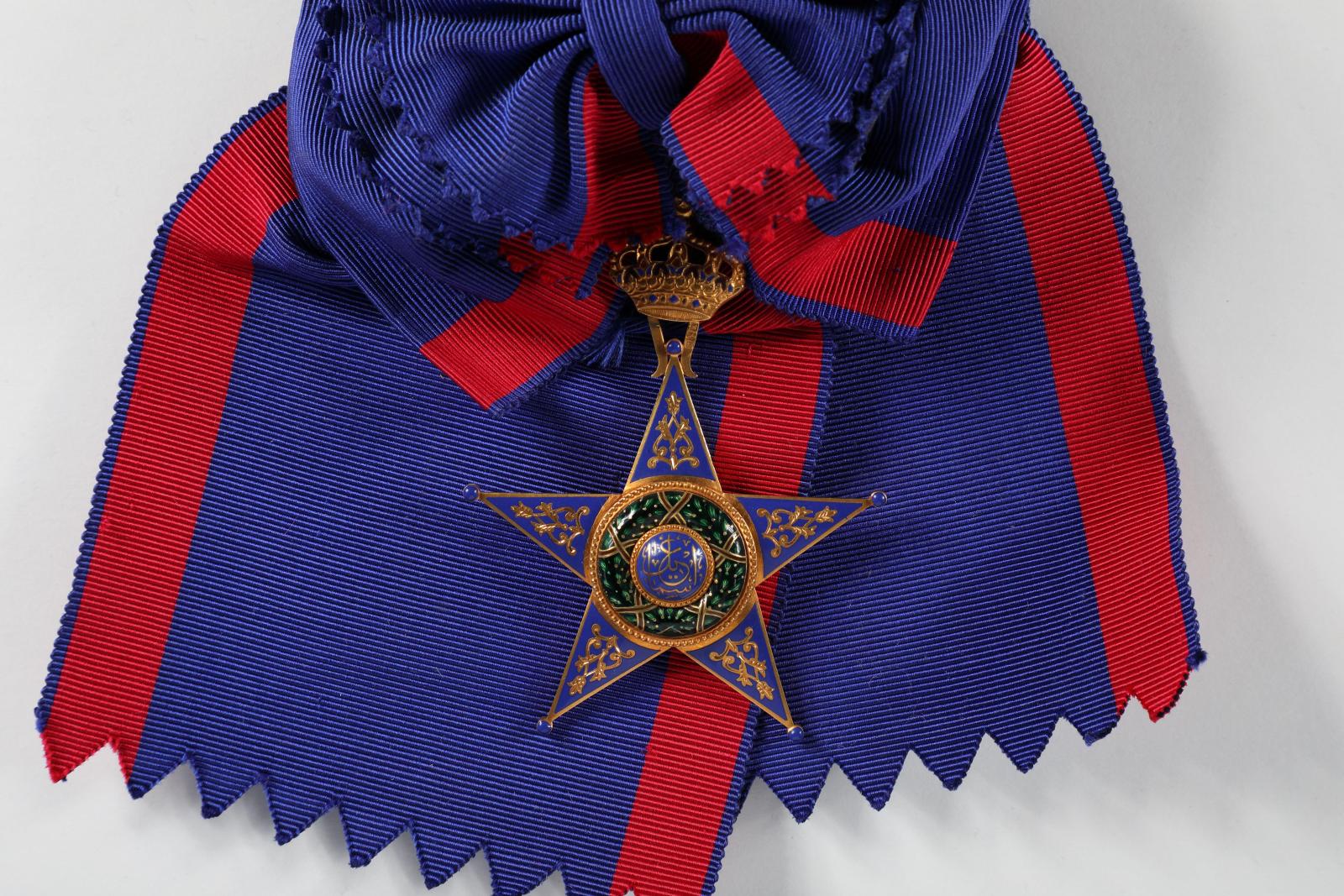
High-resolution image of the NMAH sash & sash badge (Catalogue number 67.94487a) showing the obverse of the sash badge.
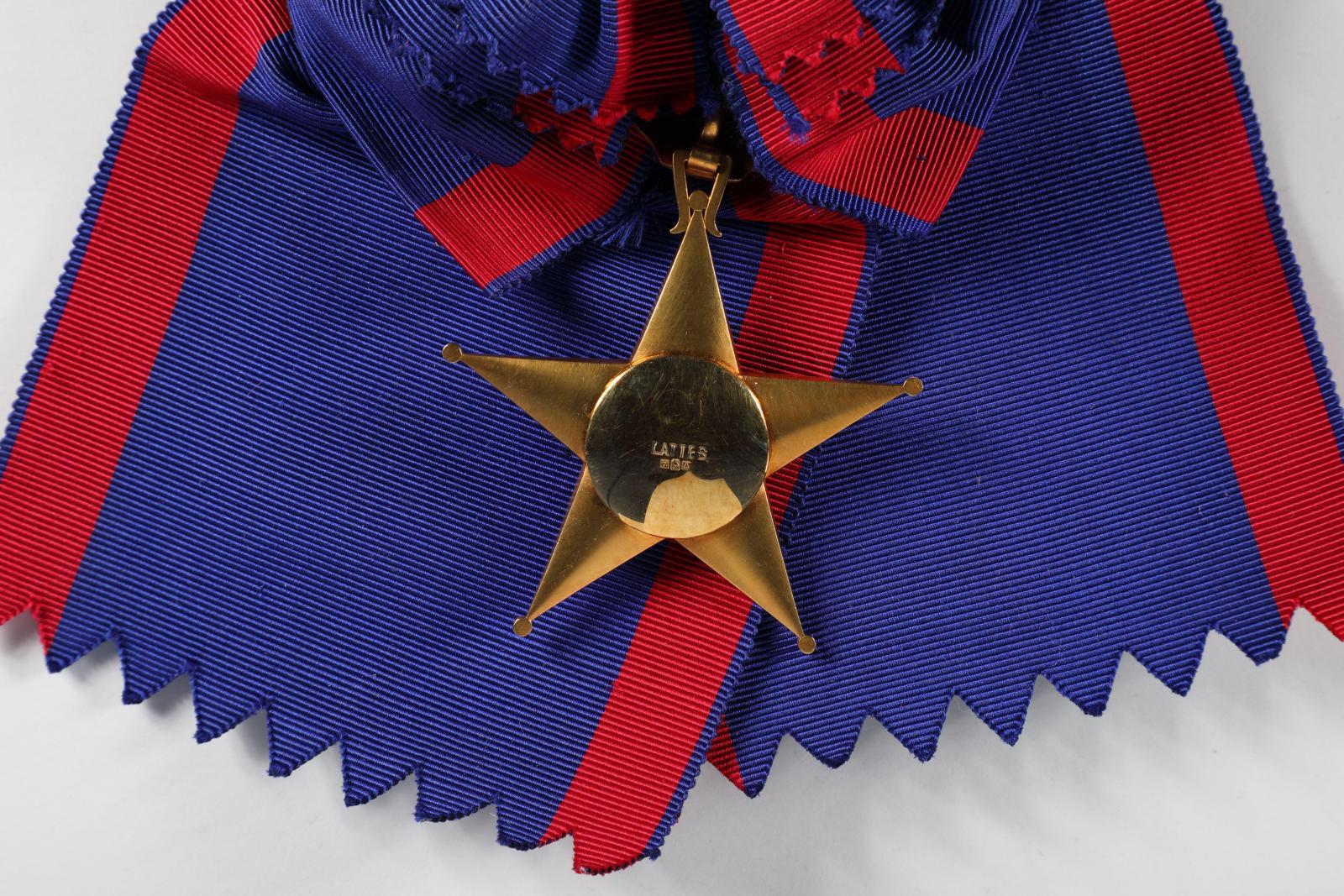
High-resolution image of the NMAH sash & sash badge (Catalogue number 67.94487a) showing the reverse of the sash badge. This image can be zoomed to see the 3 Egyptian gold hallmarks including the "A" assay date mark.
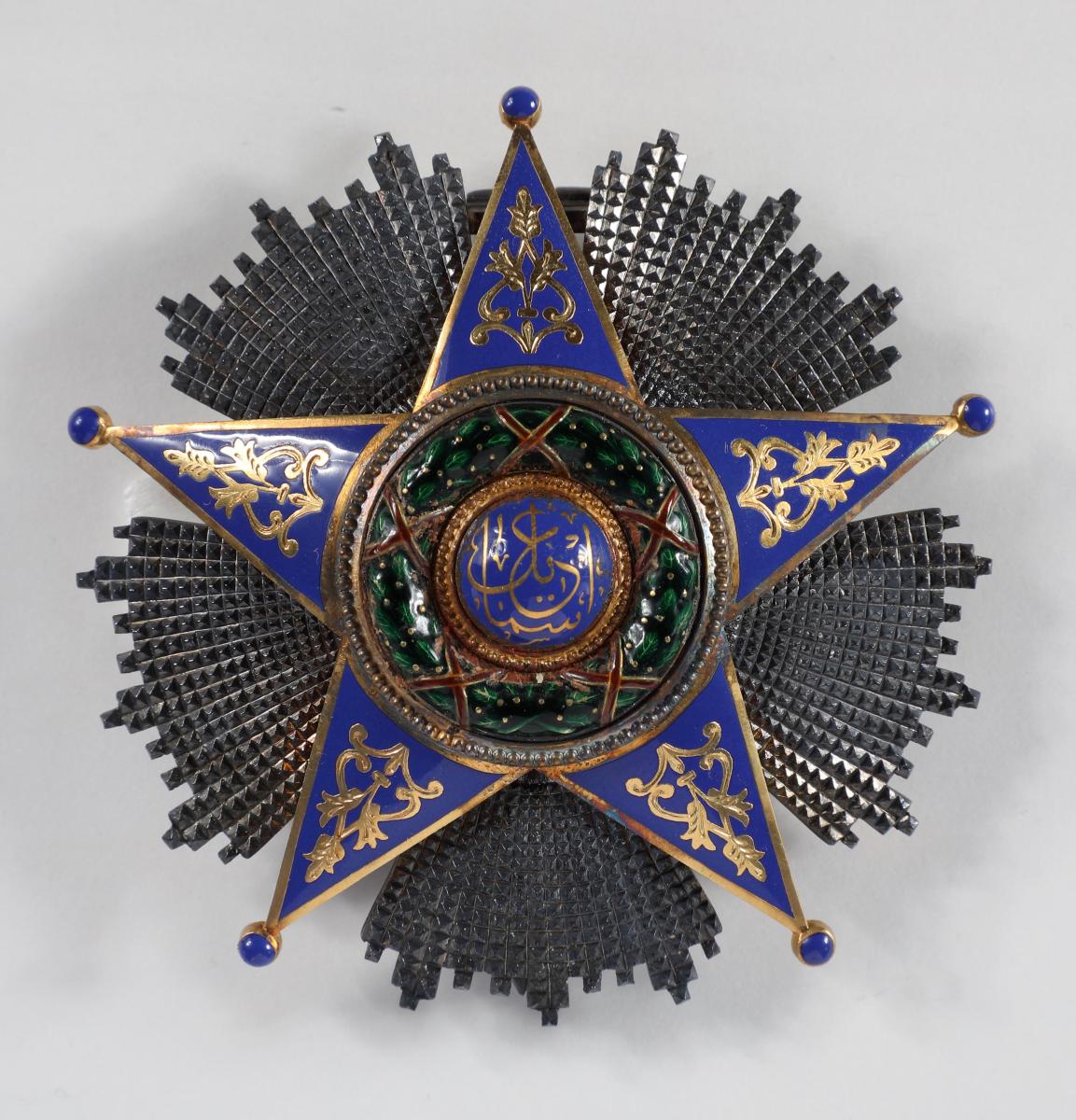
High-resolution image of the obverse of the NMAH breast star (Catalogue number 67.94487b). This can be zoomed for greater detail. This image is higher-resolution (and has better lighting) than the obverse photo of this badge shown as the 1st photo in my post of 19 November, 2022. Note that after the recent curation efforts, whatever the reddish material is around the central boss with the "Ismail" inscription has not been cleaned off.
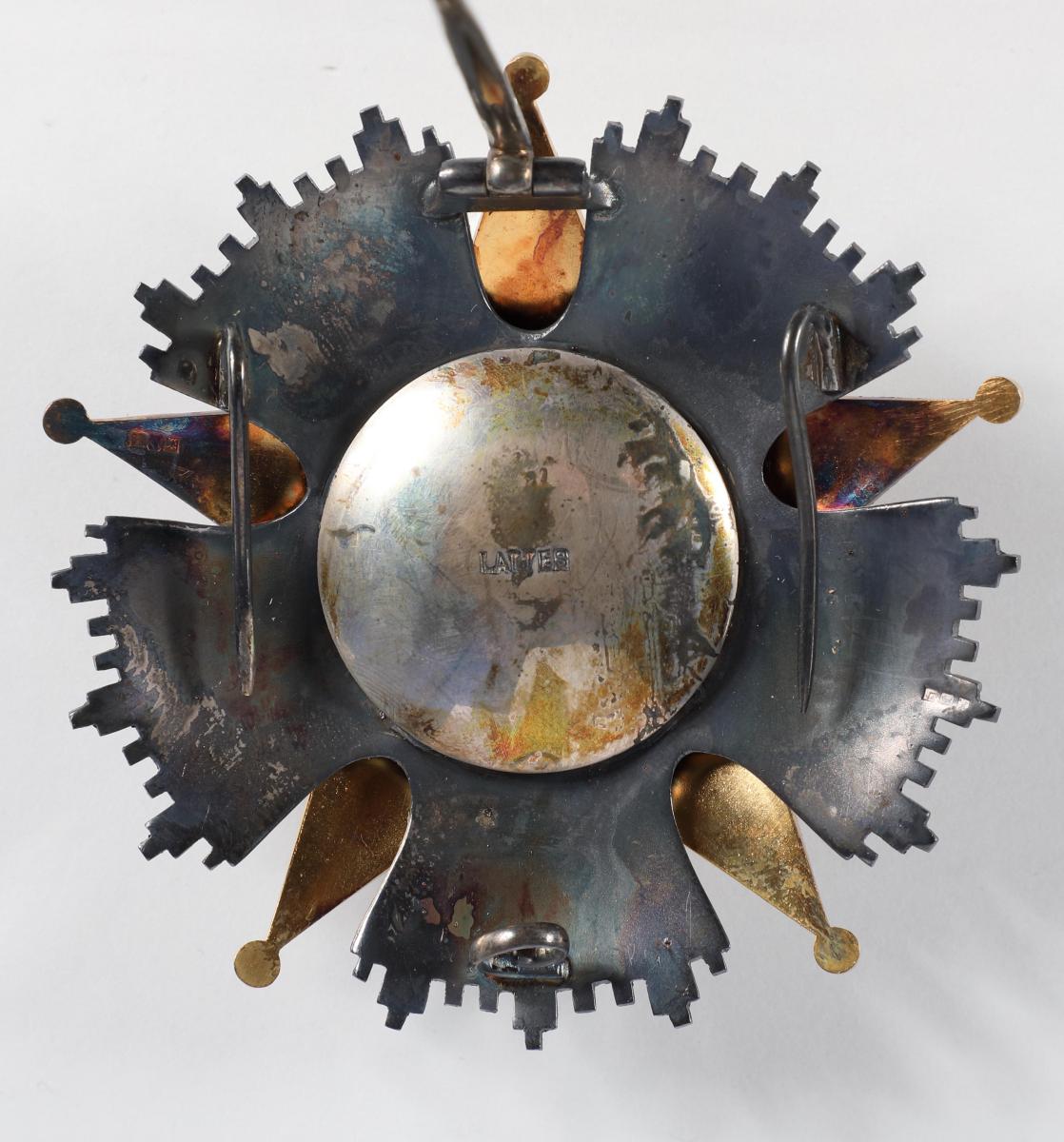
High-resolution image of the reverse of the NMAH breast star (Catalogue number 67.94487b). This can be zoomed for greater detail. This photo is higher-resolution than the obverse illustration of this breast star shown in the 2nd and 3rd images in my post of 19 November, 2022. The lighting and resolution does not show clearly the date hallmark on either the silver embellishment (on the central ray of the embellishment in the ~4:00 position) or the gold date hallmark on the left upper arm (in the ~ 9:30 position). The gold date hallmark "A" is clearly shown in the close-up image provided by the NMAH staff photographer as the 4th image in my post of 19 November, 2023.
0 -
Howdy Chris,
I have written the author, Magdy Hanafy, asking about any better price than the eBay source. I have not heard back from him, he may not read English. I have someone in my office who is going to Cairo in March and has expressed a willingness to bring home a few of these oversized/heavy volumes. However, I do not yet have an alternative source.
Is there anything you would particularly like to see that I could scan for you?
Cheers,
Rusty
0 -
I was recently contacted about an alleged Mixed Courts badge offered for sale to a customer visiting Cairo. I do not wish to name the shop as the owner has been very professional in addressing my concerns about the authenticity of this particular badge. The badge illustrated in low-resolution images below appears to me to be a chimera of a possible original Froment-Meurice rayed embellishment, a highly unusual central component with the mantle design element, and possibly an original central calligraphic tablet from one of the 4 unidentified manufacturers of these badges.

Low-resolution image of the obverse of this problematic badge. Although it is hard to see many details of this badge, several anomalies are readily apparent in the mantle component. The most obvious design oddity is the very parallel depiction of the folds in the superior portion of the mantle extending from the inferior margin of the crown laterally to the corners tied with tasseled cords. These are 4 parallel folds on each side, quite unlike the more irregular fabric folds seen on this portion of the mantle drapery even in the least detailed versions of these badges. Also note that the tassels on the right corner are approximately the same length, with the lateral tassel resting just a little lower than the medial tassel. All Froment-Meurice, Stobbe, Horowitz (except the one very odd "pin" form inspired by the Mixed Courts badge shown most recently in 2 examples shown in my 7 April , 2022 post on this thread), the one example by D. Ialanos, A. de Leon, & A. Kassandinos of Alexandria, and all the unmarked badges and those by unknown manufacturers have the rightmost lateral tassel situated slightly above the right medial tassel. The only exception are the badges made by Zivy Fréres & Cie where they also are the same length. Additionally, the thick frame around the central calligraphic tablet is not present on any other Mixed Courts badges by any maker. Quite noticeably, it appears there is no texturing of the interior of the mantle that is designed to indicate fur, with some ermine tails placed on the interior as well. Although the photo is not good enough resolution to see the background in detail, there is no indiction of any texturing. Additionally only 7 ermine tails are present, all in the lower portion of the mantle interior lateral to the proximal branch ends of the oak and laurel branches, and around the Order of Medjidie emblem. No ermine tails are present in other portions of the mantle, as are seen in all other Mixed Courts badge examples. Although difficult to compare details about these ermine tails, even in these photos they appear quite different, like stylized cylinders with apparent small knobs on each, most at the inferior end and some at the superior ends of each tail.
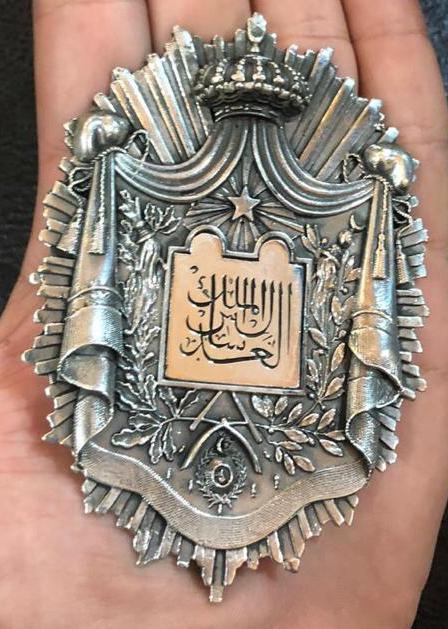
Another view of the obverse of this same badge. unfortunately also a low-resolution photo. The form of the calligraphy has a distinctive variations in the form of the the script of the uppermost siin that is uniquely configured on this and 3 other examples I illustrated as the 24th-27 photos in my post of 6 September, 2021 on this thread. It is likely that this is an authentic central tablet from another of these unmarked and currently unknown manufacturers of Mixed Courts badges. Again, note the anomalous thick frame around the central tablet. If this image is zoomed, there may be some visibility of the thin outline of the tablet as seen on all other badge, The uncommon form of the calligraphy makes me suspect this is more likely an original component than one copied from other badges (where different calligraphy is much more frequently seen than this minor variant with the unusual form of the uppermost siin character). Although slightly better visible in the previous photo, several design details are less skillful crafted and detailed on the mantle element of this badge. The tughra in the Order of Medjidie looks particularly small and anemic, and comparisons of the oak and laurel leaves and the distal ends of the tugs also show much less detailed execution than most examples. This mantle component is distinctly different and less intricately executed than even on the least detailed authentic badges' workmanship: the 2 examples of badges made by Zivy Fréres & Cie. (shown in my posts of 24 April, 2019, and 22 February, 2023 on this thread) and the 2 cast versions made by D. Ialanos, A. de Leo, & A. Kassandrinos (shown in my post of 3 February, 2022).
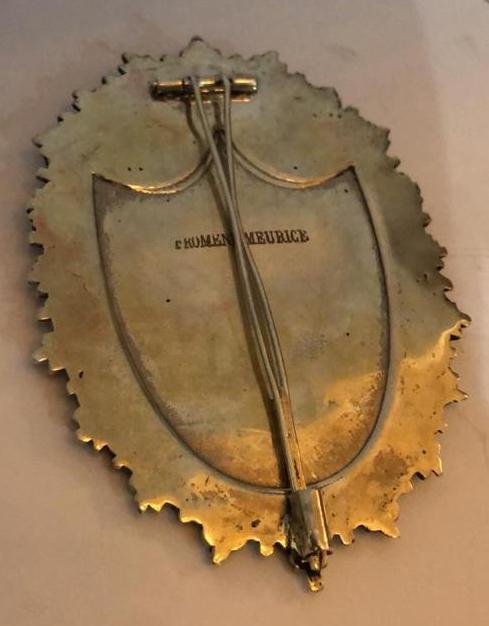
Low-resolution image of the reverse of this same badge. The rayed embellishment marked with the Froment-Meurice name may be a genuine component. However, no aspects of the mantle element match the workmanship of any other Froment=Meurice badges. The form of the calligraphy on the central tablet also is unlike that seen on any marked or suspected Froment-Meurice badges. Additionally, the workmanship associated with the body of the authentic badges with this same calligraphic version of their tablets also is completely unlike any example that can reasonably be attributed to Froment-Meurice. This combination of the 3 pieces that form this badge shows no conformation with any known single maker. As noted, the mantle element is dissimilar to all other badge examples, including those that are among the 4 unidentified manufacturers. It is the anomalous individual elements that make me suspect this represents a modern chimera assembly from three unassociated pieces.
0 -
I have found a couple photographs of storefronts of Rudolf Stobbe (one of the manufacturers of Mixed Court badges) that I just encountered on the Great Egypt website (https://www.greategypt.org/2023/05/rudolf-stobbe.html). The short descriptive text associated with these two photos identifies Rudolf Stobbe as a native of Graudenz, at the time a province of Prussia (following WWII it became part of Poland). Stobbe studied in important jewelry workshops in Berlin, Paris, and Vienna and emigrated to Egypt in approximately 1880 at the age of 28. Much of his early jewelry copied Ancient Egyptian motifs, principally in gold and precious stones. He eventually developed a reputation for himself, and created his own modern works in gold, silver, and stones. Like most bijouterie in Egypt, Stobbe also imported European-made watches for sale at his storefronts (see the following description from a 16 May, 2011 sale by Christie's of a rare A. Lange & Söhne minute repeating clock watch sold to R. Stobbe in Alexandria, Egypt, on 27 April 1911 for the amount of 2210 marks, which was engraved in Arabic on the dial to the client Ahmed Kheir Bashi: https://www.christies.com/en/lot/lot-5431070).

This photograph is identified as: "Rudolf Stobbe's premises in Alexandria". This should be the 29 rue Chérif Pasha, Alexandria address. Note the storefront sign that identifies the founding date of Maison Stobbe as 1885. This locations was Stobbe's first workshop in Egypt.
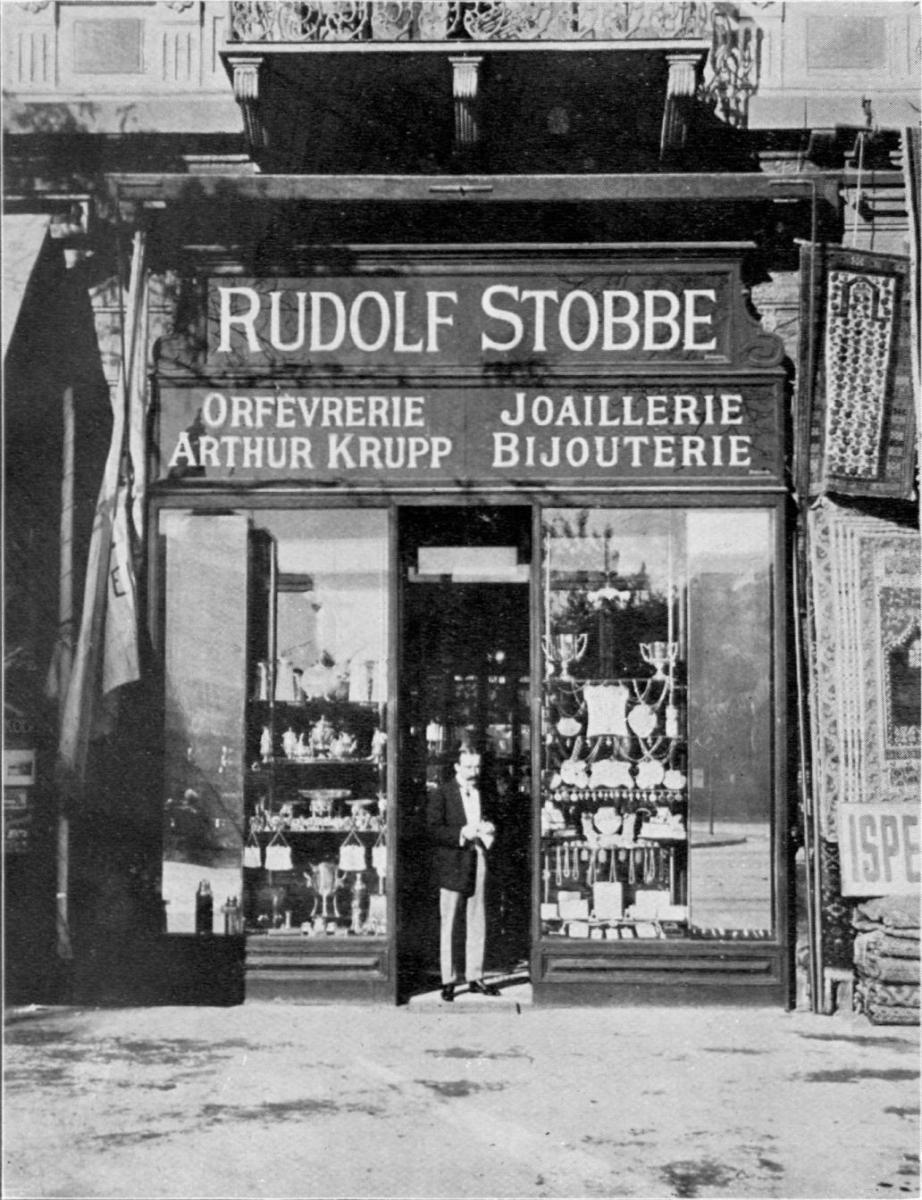
The above image is captioned on the Great Egypt website as: "The Premise of Rudolf Stobbe, Opera Square, Cairo". The text associated with this entry in Great Egypt states that the Cairo workshop at the Place de l'Opéra and storefront was opened in 1904. That source also identifies Stobbe as employing "30 specialists and eight native workmen". Apparently this location was managed by a Mr. Sheffield. The individual in the doorway may be Rudolf Stobbe (although the portrait below shows him with less head hair) or perhaps Mr. Sheffield
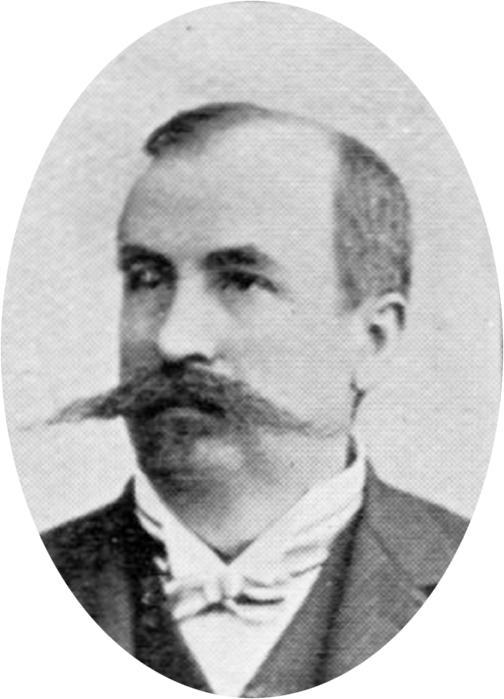
Undated portrait photo of Rudolf Stobbe, also from the Great Egypt website (https://www.greategypt.org). This portrait comes from an unspecified 1909 report on European and Egyptian businesses and their founders in Egypt.
0 -
Howdy EJ, thanks for the question about documentation. Unfortunately no, and no footnotes or general references to track the sources. Below is the material on Lattes in: Magdy Hanafy, 2023. Encyclopedia of Egyptian Protocol: Collars, Orders and Medals 1914-1953. Friends Group for Philately and Numismatics, Cairo. pp. 342-343. This small portion of the recent Hanafy volume is reproduced solely for research purposes. This is probably a copyrighted work.
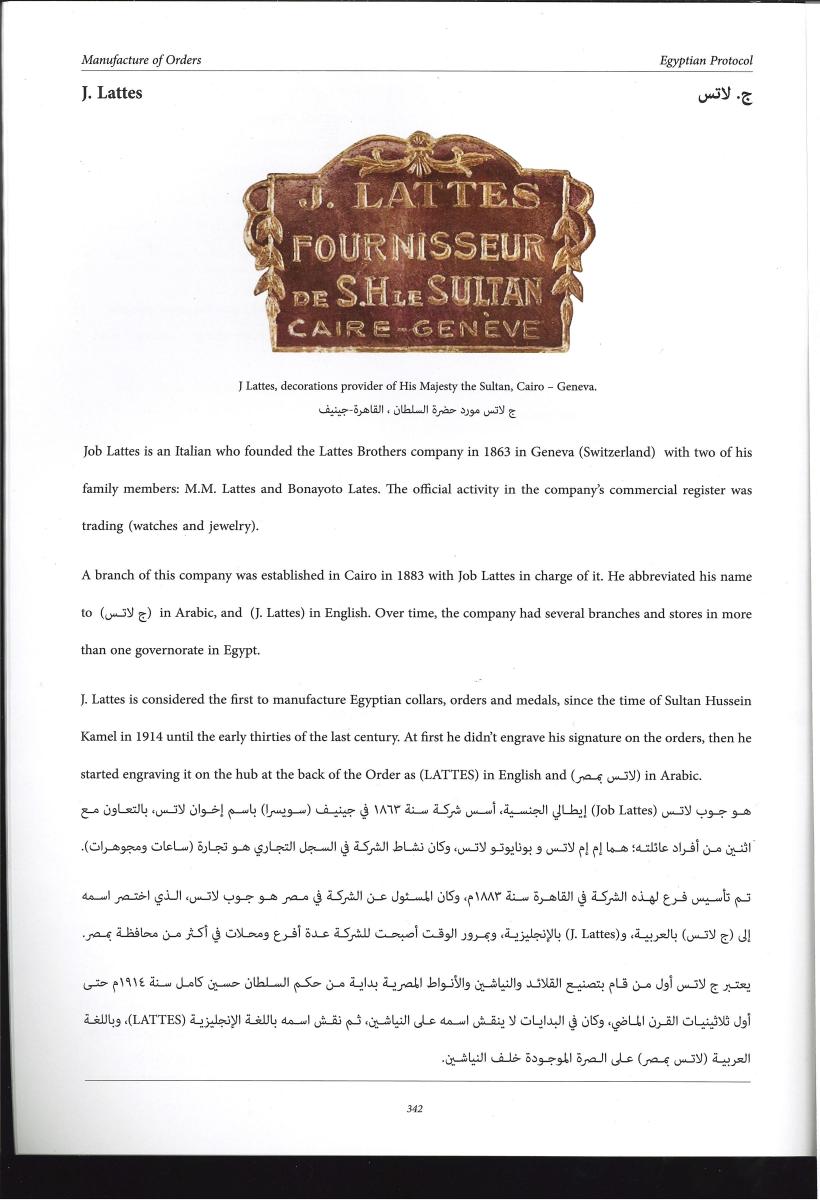
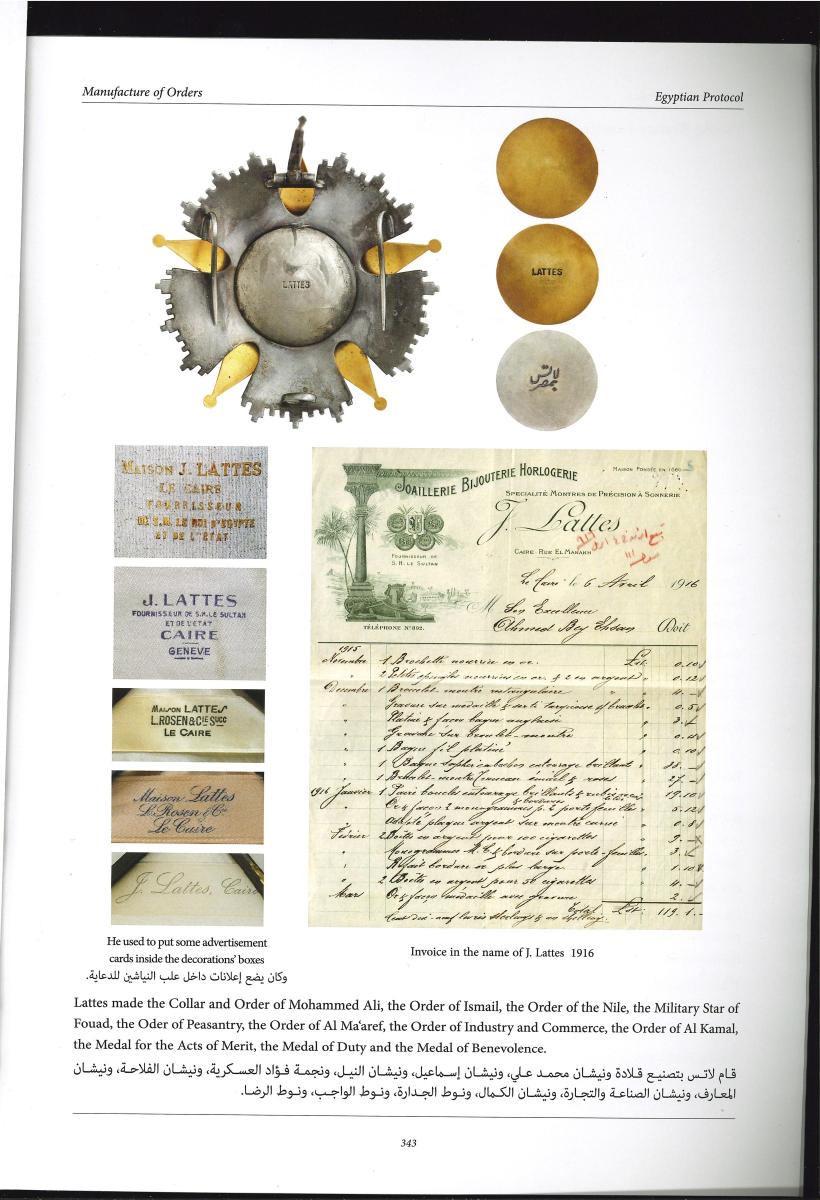
Below is the Hanafy discussion of the Bichay family: Magdy Hanafy, 2023. Encyclopedia of Egyptian Protocol: Collars, Orders and Medals 1914-1953. Friends Group for Philately and Numismatics, Cairo. pp. 342-343, again for research purposes only. .
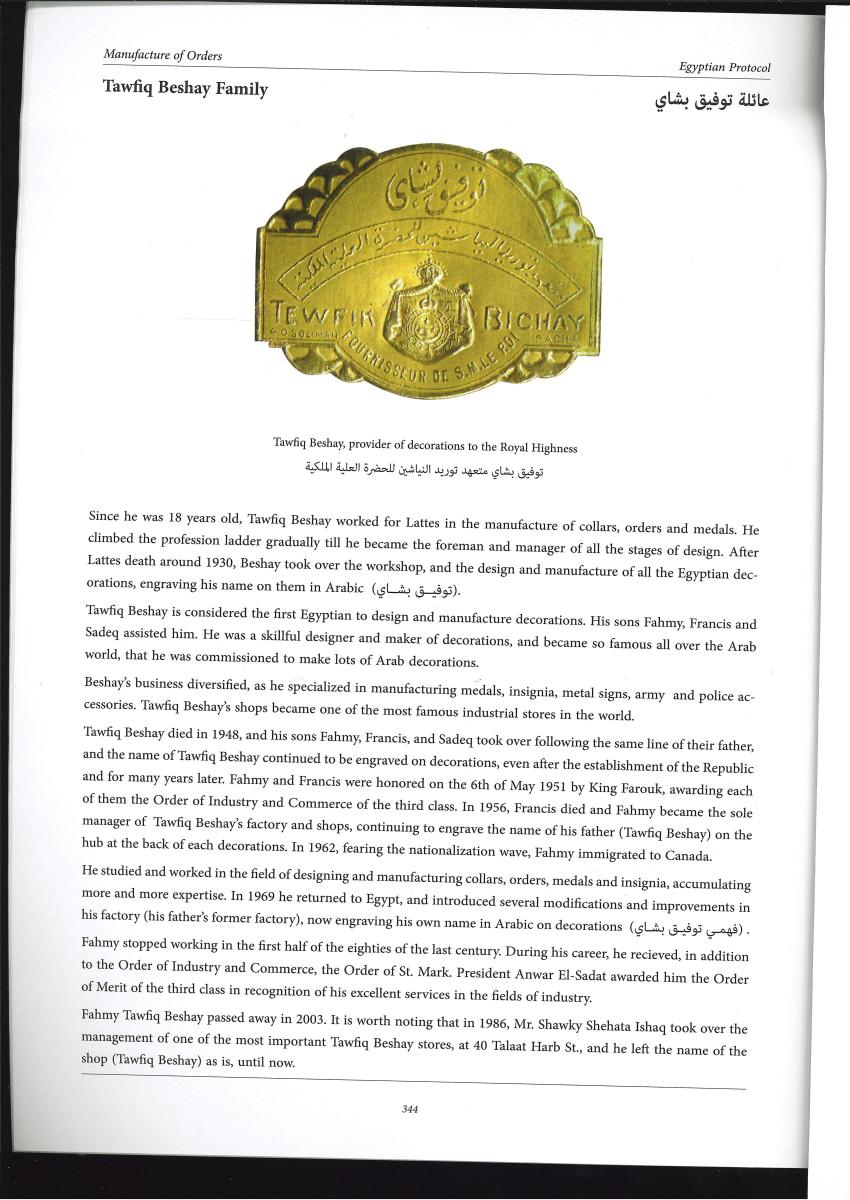
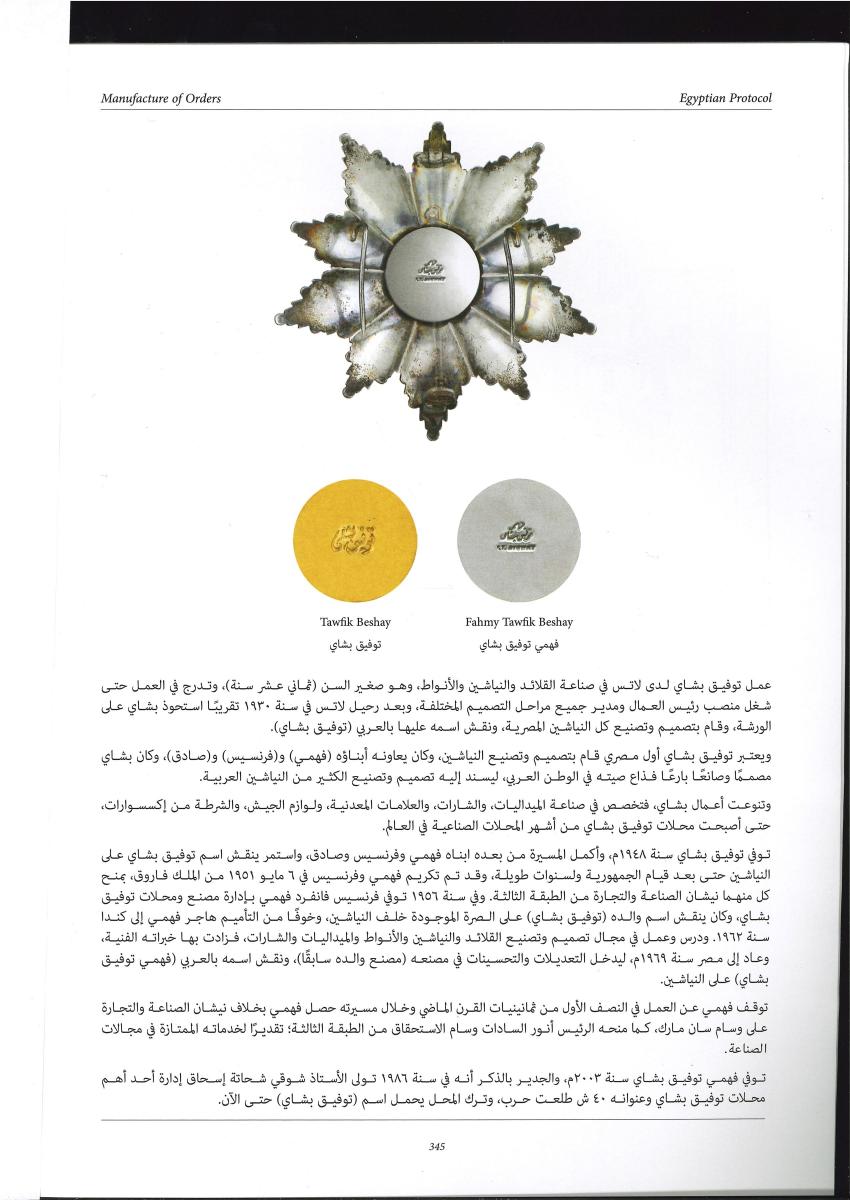
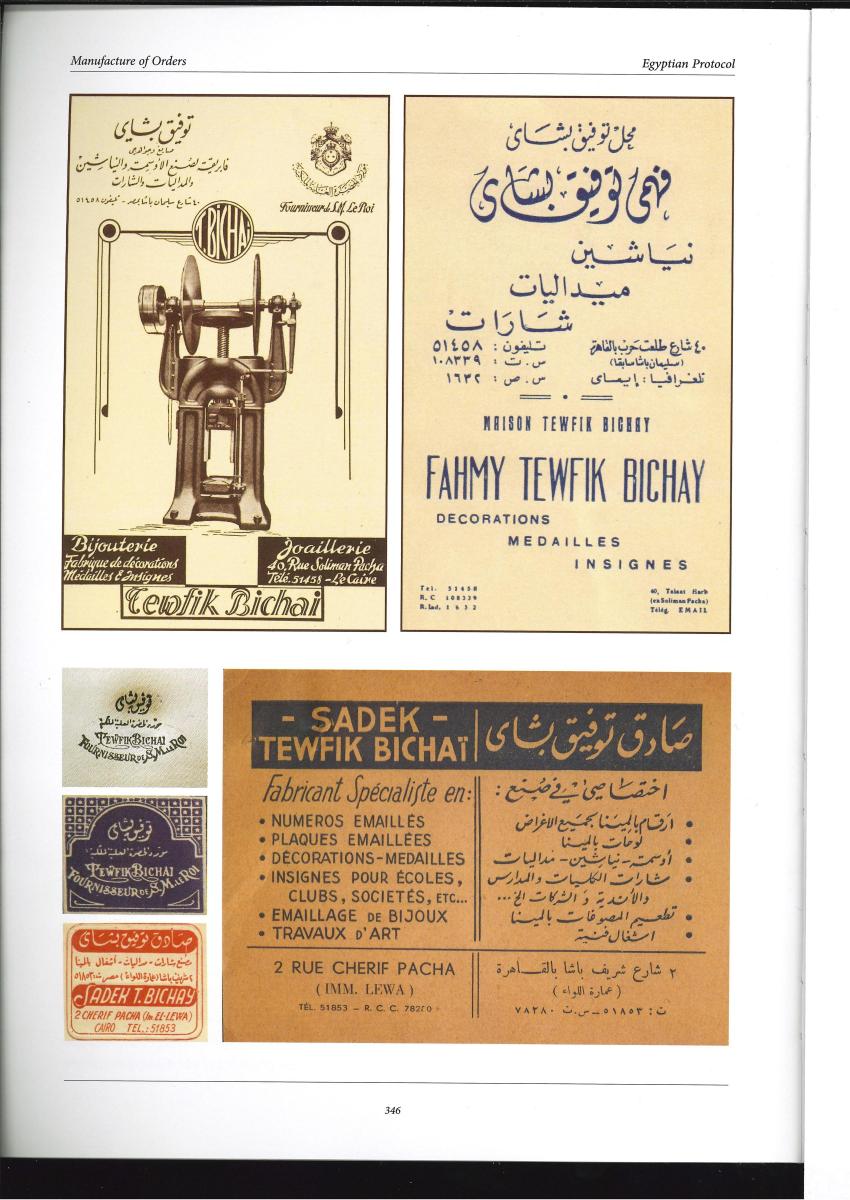
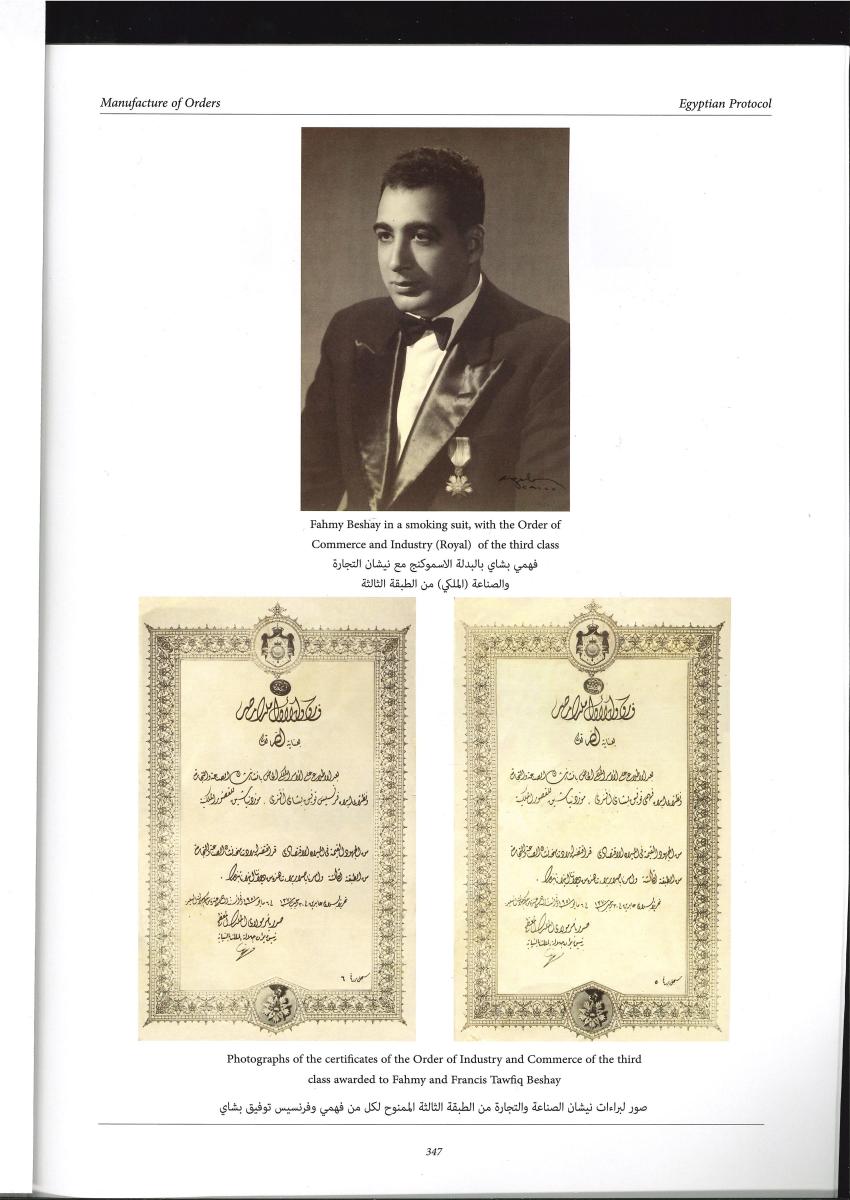 0
0




Question about the Order of Ismail/Nishan al-Ismail
in Middle East & Arab States
Posted · Edited by Rusty Greaves
Above is an advertising card for Tewfik Bichay from a recent eBay offering. The text is identical to that seen on the back page of an Arabic and English language advertising flyer for Tewfik Bichay. The back page of that flyer is shown as the 6th photo in my post on this thread of 21 September, 2020. This card has holes at the top from being stapled to something in the past. There are no markings on the reverse. This card measure 124 mm wide x 92 mm tall.